#1943 Muny
Explore tagged Tumblr posts
Text
Birthdays 9.22
Beer Birthdays
Lord Chesterfield; English statesman (1694)
Alfred Vinzenz Werthmueller (1835)
George Kennth Hotson Younger (1931)
Carlos Sanchez (1958)
Dave McLean (1969)
Five Favorite Birthdays
Bilbo Baggins; Hobbit character
Frodo Baggins; Lord of the Rings character
Michael Faraday; English scientist (1791)
Joan Jett; rock singer, guitarist (1958)
Tatiana Maslany; Canadian actor (1985)
Famous Birthdays
King Sunny Ade; Nigerian reggae singer (1946)
Scott Baio; actor (1960)
Eric Baker; English activist, co-founded Amnesty Int’l (1920)
Toni Basil; pop singer (1943)
Elizabeth Bear; author and poet (1971)
Shari Belafonte; actor (1954)
Maurice Blanchot; French philosopher (1907)
Andrea Bocelli; Italian singer-songwriter (1958)
Debby Boone; pop singer (1956)
Barthold Heinrich Brockes; German poet (1680)
Harold Carmichael; Philadelphia Eagles WR (1949)
Nick Cave; rock musician (1957)
Neil Cavuto; journalist and author (1958)
Ellen Church; 1st airline stewardess (1904)
Dave Coverdale; rock singer (1951)
Quintin Craufurd; Scottish author (1743)
Babette Deutsch; poet (1895)
Ashley Eckstein; actress (1981)
Will Elder; illustrator (1921)
György Faludy; Hungarian poet & author (1910)
Tom Felton; English actor (1987)
Grigory Frid; Russian pianist & composer (1915)
Philipp Nicodemus Frischlin; German mathematician, astronomer & poet (1547)
Theodore Hook; English composer (1788)
John Houseman; actor (1902)
Bonnie Hunt; actor (1964)
Ruth Jones; Welsh actress (1966)
Anna Karina; actor (1940)
Brian Keene; novelist (1967)
Charles Keeping; English author & illustrator (1924)
Allan "Rocky" Lane; voice of "Mr. Ed" (1909)
Tommy Lasorda; Los Angeles Dodgers coach (1927)
Paul Le Mat; actor (1945)
Katie Lowes; actress (1982)
Matthäus Merian; Swiss-German engraver & cartographer (1593)
Ian Mortimer; English historian & novelist (1967)
Paul Muni; actor (1895)
Catherine Oxenburg; actor (1961)
Peter Simon Pallas; German zoologist & botanist (1741)
Rupert Penry-Jones; English actor (1970)
Sue Perkins; English comedian, actress (1969)
Saul Perlmutter; astrophysicist, astronomer (1959)
Rosamunde Pilcher; English author (1924)
Billie Piper; English singer, actor (1982)
Arthur Pryor; trombonist, composer (1870)
Paolo Ruffini; Italian mathematician & philosopher (1765)
Martha Scott; actor (1914)
Elizabeth Simcoe; English-Canadian painter & author (1762)
Bill Smith; clarinet player & composer (1926)
Theodore Clement Steele; artist (1847)
Michael Torke; composer (1961)
Ken Vandermark; saxophonist & composer (1964)
Charles Waterhouse; painter (1924)
Fay Weldon; English writer (1931)
Billy West; actor (1892)
Ray Wetzel; trumpet player & composer (1924)
1 note
·
View note
Text

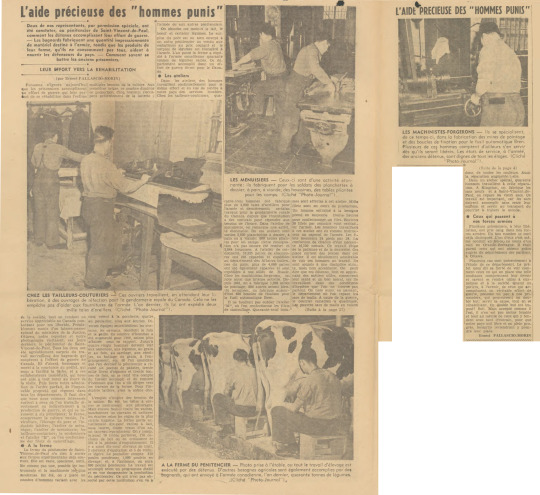
"L'EFFORT DE GUERRE DES "HOMMES PUNIS"," Photo-Journal. July 15, 1943. Page 1. ---- Grâce à un laisser-passer spécial, nos représentants ont pu aller constater, au pénitencier de Saint-Vincent-de-Paul, comment les détenus travaillent, eux aussi, pour notre commune victoire sur les forces de l'Axe. On lira ce reportage en page 4. Ci-haut, à gauche, photo prise dans l'atelier "M", où un prisonnier est à tresser un filet de camouflage, destiné à sauver des vies et du précieux matériel de guerre sous le feu de l'ennemi; ce filet aura réclamé, une fois terminé, la ligature de seize mille, cinq cents noeuds! A droite, des cordonniers réparent des souliers qui seront expédiés au département des Affaires indiennes ou à nos héroïques alliés de Russie. (Clichés "Photo-Journal". Voir article et autres vignettes en page 4). /// "A SAINT-VINCENT-DE-PAUL: L'aide précieuse des 'hommes punis'," Photo-Journal. July 15, 1943. Page 4 & 37. --- Deux de nos représentants, par permission spéciale, ont été constater, au pénitencier de Saint-Vincent-de-Paul, comment les détenus accomplissent leur effort de guerre. - Les bagnards fabriquent une quantité impressionnonte de matériel destiné à l'armée, tandis que les produits de leur ferme, qu'ils ne consomment pas tous, aident à nourrir les défenseurs du pays. - Comment savent se battre les anciens prisonniers. ---- LEUR EFFORT VERS LA REHABILITATION ---- (par Ernest PALLASCIO-MORIN) --- Personne n'ignore aujourd'hui que les prisonniers accomplissent un effort de guerre qui leur permet de se réhabiliter dans l'estime de la société, tout en rendant un service appréciable au Canada combattant pour ses libertés. Préalablement munis d'un laissez-passer spécial du ministère de la Justice, Ottawa, notre reporter et notre photographe visitaient, ces jours derniers, le pénitencier de Saint-Vincent-de-Paul. Tous les deux ont été agréablement surpris du travail merveilleux des bagnards qui coopèrent à l'effort de guerre du Canada. Et d'abord, hommage et merci à la courtoisie du préfet, qui nous a facilité la tâche, et à ses collaborateurs immédiats, qui nous ont aidé à tout noter au cours de la visite. Puis toute notre admiration de l'ordre parfait, de l'impeccable propreté qui règnent dans tous les départements. Il faut dire que nous nous sommes intéressés surtout à ceux où l'on travaille directement ou indirectement à la production de guerre, et qui se résument à six principaux: la ferme, comprenant la culture variée, l'aviculture, l'élevage du pore et l'industrie laitière; l'atelier de mécanique; l'atelier de menuiserie; les tailleurs-couturiers; la cordonnerie et l'atelier "M", où l'on confectionne des filets de camouflage.
A la ferme La ferme du pénitencier de Saint- Vincent-de-Paul n'a rien à envier aux fermes expérimentales déjà connues. Elle est vaste, spacieuse, outillée comme pas une, possède les instruments et la machinerie les plus modernes. En été, on y place un nombre d'hommes variant avec les multiples besoins de la culture. Aux premières neiges, ce nombre diminue en proportion. Cinq hommes s'occupent présentement de la laiterie; cinq volent à la porcherie, quatre, au poulailler, cinq aux écuries. Diverses équipes entretiennent les chemins, les caveaux, récoltent le foin et la paille. Ce nombre d'hommes a été augmenté pour l'été, saison plus affairée sous ce rapport. Jusqu'à quatre-vingts hommes doivent voir aux semences, aux légumes, au grain et au foin, au sarclage, aux récoltes, au battage du grain, à l'engrangement, etc. Si l'on considère que l'an dernier le pénitencier a récolté six poches de patates, trente mille livres d'oignons et trente tonnes de foin, on se rend vite compte du travail accompli et du nombre d'hommes que l'on a dû diriger vers les travaux de la ferme. Pour l'industrie laitière, c'est la même chose.
L'emploi s'inspire des besoins de la saison. En été, les bêtes à cornes se nourrissent aux pâturages. Mais encore faut-il traire les vaches, bouchonner les chevaux et nettoyer les écuries selon les règles de la plus stricte hygiène. La ferme garde actuellement dix-neuf vaches à lait, onze taures, douze veaux 'd'un an, un taureau reproducteur. On y compte aussi 70 truies portières, 170 cochons de lait ou en croissance et 310 à la période d'engraissement. Il y a aussi dix-neuf chevaux de trait, 2 chevaux d'équitation et 5 de volture légère. Le poulailler compte 310 poules pondeuses, 1,500 poulets en élevage: et, à l'automne, on aura 800 poules pondeuses. Le travail est accompli selon un programme établi et en vue d'augmenter la production du pénitencier. Ce qui n'est pas absorbé par cette institution s'en va à l'armée ou aux autres pénitenciers.
On absorbe ces mols-ci le lait, le bœuf et certains légumes. Le surplus du porc est ou bien envoyé à un autre pénitencier ou vendu aux emballeurs au prix courant et le surplus de légumes est transféré à l'armée. L'an passé la ferme a expédié à l'armée canadienne quarante tonnes de légumes variés. Ce département accomplit donc un effort de guerre direct pour le Canada.
Les ateliers Dans les ateliers, des hommes travaillent continuellement pour le même effort et en vue de rendre à notre pays des services louables. Chez les tailleurs-couturiers, quarante-trois hommes ont fabriqué plus de 2,000 taies d'oreillers pour l'armée et dernièrement certains travaux pour la gendarmerie royale du Canada depuis que l'institution a des contrats pour répondre aux besoins de l'heure. Dans l’atelier de menuiserie, on remarque une activité étonnante. De ces ateliers sont sorties 3,800 planchettes à dossier, à pain ou à viande; 600 tables pliantes pour les camps (cette consignation n'a pas encore été remise) et 3,944 houssines. A l'atelier de cordonnerie, 10,325 paires de chaussures ont été réparées et expédiées au département des Affaires indiennes du pays; plus de 4,000 paire sont été également réparées et sont expédiées à nos alliés de Russie. Chez les machinistes-forgerons, on note aussi une intense activité. Depuis 1941, on a fabriqué 1,028 mires de pointage; 906 autres seront, bientôt terminées; on fabrique aujourd'hui 400 boucles de fixation pour le fusil automatique Bren.
Il ne faudrait pas oublier l’atelier "M", où l'on confectionne les filets de camouflage. Quarante-neuf hommes sont affectés à cet atelier, Mille filets sont en cours de production. Un homme entraîné à la besogne prend en moyenne trente-heures pour confectionner un filet. Environ 30 filets par semaine vont ravitailler l'armée. Les hommes travaillant à cet atelier ont eu comme instructeur un caporal de l'armée. Les filets mesurent 24 pieds par 24. La confection de chacun d'eux nécessite 16,500 nœuds. Ce travail exige de la patience et de la dextérité. On place surtout des jeunes dans cet atelier. Il est absolument admirable de voir ces hommes au travail. Ils sont soumis à une discipline stricte, mais non accablante. On peut dire que ces détenus, tout en apprenant des métiers utiles, conservent leur santé et un bon moral, car ils travaillent dans des conditions d'hygiène que l'on ne trouve pas partout. On note aussi, en passant, le département où l'on répare les sacs de malle. A cause de la guerre, le courrier canadien a quadruplé. Les pauvres sacs de malle en volent donc de toutes les couleurs. Aussi la réparation augmente-t-elle.
Dans un atelier spécial, quarante hommes travaillent à cette réparation. A Kingston, on fabrique les sacs neufs et à Saint-Vincent-de-Paul, on répare les vieux sacs. Ce travail est important, car les sacs doivent accomplir sans cesse leur mission et servir au transport du courrier à travers le monde.
Ceux qui passent à nos forces armées Plusieurs prisonniers, à leur libération, ont pris rang dans nos forces armées. Un bon nombre se sont déjà distingués. L'un d'eux s'est même conduit en héros, au cours d'un raid en Grande-Bretagne. Il était parmi ceux qui ont obtenu grâce auprès du département des pardons, à Ottawa.
Plusieurs cas sont présentement à l'étude de ce département. Le préfet nous dit sa fierté de voir comment ceux en qui on place une telle confiance comprennent leur devoir et savent se rendre utiles à eux-mêmes et à la société. Quand on parlera, à l'avenir, de ceux qui accomplissent un véritable effort de guerre, pensons un peu à nos prisonniers, qui poursuivent un double but: servir la cause, tout en se réhabilitant. Ce double but est imposé? Soit. Mais accepté comme il l'est, il n'en est pas moins louable et tout au mérite de ceux qui y tendent avec tant d'entrain, pour que notre pays soit libre et en plein progrès, lorsqu'ils reviendront y prendre leur place. Ernest PALLASCIO-MORIN
Légende page 4:
CHEZ LES TAILLEURS-COUTURIERS Ces ouvriers travaillent, en attendant leur libération, à des ouvrages de réfection pour la gendarmerie royale du Canada. Cela ne les empêche pas d'aider aux fournitures de l'armée. L'an dernier, ils lui ont expédié deux mille taies d'oreillers. (Cliché "Photo-Journal").
LES MENUISIERS Ceux-ci sont d'une activité étonnante: ils fabriquent pour les soldats des planchettes à dossier, à pain, à viande, des houssines, des tables pliantes pour les camps. (Cliché "Photo-Journal").
A LA FERME DU PENITENCIER Photo prise à l'étable, ou tout le travail d'élevage est exécuté par des détenus. D'autres besognes agricoles sont également accomplies par des bagnards, qui ont envoyé à l'armée canadienne, l'an dernier, quarante tonnes de légumes. (Cliché "Photo-Journal") Légende page 37:
LES MACHINISTES-FORGERONS Ils se spécialisent,de ce temps-ci, dans la fabrication des mires de pointage et des boucles de fixation pour le fusil automatique Bren. Plusieurs de ces hommes comptent d'ailleurs s'en servir dès qu'ils seront libérés. Les états de service, à l'armée, des anciens détenus, sont dignes de tous les éloges. (Cliché "Photo-Journal").
#st vincent de paul penitentiary#laval#montreal#war production#prison industries#prison industrial complex#convict labour#work will set you free#rehabilitation#life inside#photojournalism#canada during world war 2#crime and punishment in canada#history of crime and punishment in canada#war effort#total war
2 notes
·
View notes
Text
Glossaire " Ce que sait la main"
Ce que sait la main ?
Richard Senneth : C’est un sociologue et historien américain né le 1ᵉʳ janvier 1943 à Chicago. En 2010 il écrit « Ce que sait la main, la culture de l’artisanat » Dans ce récit, il propose une définition de l’artisanat beaucoup plus large que celle de "travail manuel spécialisé". Il élargit donc la notion d’artisanat à tout travail qualifié impliquant la main, et visant l'excellence. Il dénonce donc une interprétation restrictive de l’artisanat comme un travail manuel, mais qui serait plus profondément liée à l’ambiguïté de la technique dans la civilisation occidentale. A travers cet ouvrage Richard Sennett prouve que "Faire, c’est penser".
La main : Selon Larousse la main est un organe de la sensibilité muni de cinq doigts, et qui constitue les membres supérieurs de l’homme. Mais dans un domaine plus philosophique comme le dit Aristote, « Ce n’est pas parce qu’il a des mains que l’homme est le plus intelligent des êtres, mais c’est parce qu’il est le plus intelligent qu’il a des mains » Car en réalité la nature nous à donné un outil de loin le plus utile : la main. Mais elle n'est pas un seul outil, elle en regroupe plusieurs en un. Donc l’être le plus intelligent est celui qui sera capable de bien utiliser la main.
L’artisanat : C’est l’ensemble des activités manuelles visant à la transformation de produits ou à la mise en œuvre de services grâce à un savoir-faire particulier. L’artisan a besoin de travail, de technique, de savoir-faire, de temps ainsi que sa main, « son principal outil » pour la fabrication de ses pièces. L’artisan réalise des pièces uniques ou en petite série. On remarque donc que l’artisanat est en opposition avec le domaine industrielle. Puisqu’en industrie, tout est fait à partir de machine et tout est produit en grande série ou en masse.
La technique : C’est un ensemble de procédés et de moyens pratiques propres à une activité. En effet pour réussir à exercer des activités il faut être en mesure d’acquérir diverses techniques. Mais d’un point de vue philosophique la technique c’est l’ensemble des procédés utilisés par l'être humain pour transformer la nature par le travail. La technique permet alors à l'être humain de maîtriser son environnement. En effet L’homme est doté de d’outils comme la main, mais sans technique l’outil n’est rien. Au fur et à mesure l’homme va découvrir diverses techniques et va pouvoir découvrir et modifier son environnement.
La création : C’est l’action de créer, donner l’existence à quelque chose, qui faisait partit ou non de la réalité auparavant. La création peut faire preuve d’imagination et peux avoir besoin de technique. Par exemple la création manuelle requiert une certaine technique, notamment avec les mains, pour avoir un résultat qualitatif à la fin. On peut aussi créer à partir de rien.
L’intelligence : C’est la Faculté de connaître, de comprendre ; c’est une qualité de l'esprit qui comprend et s'adapte facilement. Par exemple dans « Ce que sait la main » on remarque, que Richard Senneth nous montre que la main à une certaine intelligence. Par exemple un artisan parvient à anticiper les sensations lors de la saisie d’outils et arrive à ajuster ses gestes en fonction de cette intuition. Les gestes les plus anodins, font donc appel à notre esprit et donc à l’intelligence de la main.
Homo faber : En latin Homo Faber, signifie « homme constructeur ». C’est donc un homme maître de la technique appliquant son intelligence à la fabrication et à la création. Il fabrique les outils et donc il fabrique aussi les choses…Et selon Hannah Arendt, l’homo faber assure la solidité du monde, et il est capable de juger de façon éthique son travail.
L’animal laborans : L'animal laborans est une figure de l'homme sans monde, sans horizon, sans transcendance, voire même qui détruit son propre monde. Selon Annah Arendt L’animal laborans complètement absorbé par sa tâche, est immoral. L’animal laborans est donc tout le contraire de l’homo faber car ce dernier est intelligent et créateur alors que l’animal laborans est immoral. La thèse de Hannah Arendt revient donc à affirmer que l'activité humaine, en tant qu'elle est humaine, excède toujours la question du vital et de l'utile.
Didier Schwint : On peut voir que Didier Schwint à travers « la routine dans le travail de l’artisan » dans Ethnologie française en 2005, confirme que la pratique routinière occupe une place centrale dans le travail de la fabrication, elle représente la phase la plus élaborée et l’objectif ultime de la réalisation. Le rythme et le coup de main, sont les meilleurs états de mémorisation. Par exemple dans l’artisanat c’est en faisant toujours les mêmes mouvements, les mêmes gestes, en faisant toujours les mêmes actions, qu’on va réussir à progresser, et à mieux comprendre et mémoriser ces gestes.
Répétition : Action de reproduire plusieurs fois, recommencer une action….La répétition est lié à la routine puisque c’est grâce à la répétition quotidienne qu’on arrive à mémoriser et à s’améliorer. La répétition d’un geste lors de la fabrication, va permettre d’obtenir un résultat qualitatif, et plus on répète un mouvement, plus on va réussir à le contrôler, à le manipuler. Et lorsque nos gestes sont maîtrisés, on arrive à avoir un résultat final propre et correct.
Geste : Le geste c’est une action de mouvement du corps principalement des bras, de la tête mais surtout des mains, dans un but de préhension, de manipulation, d’exécution de quelque chose. Dans la réalisation d’objets artisanaux le geste exercé par la main sur un outil va permettre de déterminer la forme, la taille, l’épaisseur… de l’objet. Le geste est très important il faut également bien le connaître et le retenir. Lors de la fabrication, si le geste n’est pas le même à chaque fois le produit final ne sera pas forcément convainquant.
Outil : Objet fabriqué, utilisé manuellement, il sert à agir sur la matière, ou à faire un travail. Il ne faut pas oublier, que la main est le principal outil. Mais lorsque l’on utilise un outil fabriqué, la main va être maître de l’outil et elle va le guider pour obtenir un geste convenable. On en déduit que l’outil fabriqué est un instrument et que c’est la main qui fait le travail. L’outil permet d’obtenir de nouveau résultat sur la matière que la main ne peut pas réaliser toute seule.
Ergonomie : C’est un terme grec qui correspond à l'étude scientifique de la relation entre l'humain et ses moyens, méthodes et milieux de travail ainsi que l'application de ses connaissances à la conception de systèmes qui puissent être utilisés avec le maximum d'efficacité par le plus grand nombre. L’ergonomie est très importante car elle permet à l’utilisateur de s’adapter à son environnement de travail c’est-à-dire aux outils, aux matériaux……Par exemple pour qu’un outil soit convenable pour une utilisation, il faut qu’il soit assez confortable pour la main (qu’on ai une bonne prise demain) et qu’il réponde aux problèmes de sécurité.
Imagination : Consiste à former des images d'objets qu'on ne perçoit pas ou de faire des combinaisons nouvelles d'images ou d'idées, pour se représenter des situations possibles. Lors de la fabrication d’objet, la technique, la création et la pratique sont très importantes mais l’imagination a aussi sa place. Puisqu’avant de créer un objet, et de se servir de sa main il faut faire recours à notre imagination pour définir quelles formes, matériaux, couleurs, taille…. aura notre futur objet. On peut aussi se servir de notre imagination pour rendre original notre objet et qu’il puisse donc se différencier des autres.
Réflexion : C’est le fait d'arrêter sa pensée sur quelque chose en vue de l'examiné en détail. Dans l’artisanat on nécessite d’une certaine réflexion pour le choix des matériaux, de la forme pour que l’objet soit fonctionnel. Mais on utilise également notre réflexion pour utiliser correctement un outil, comment positionner la main, quel geste doit elle faire pour que l’outil fonctionne bien, quel mouvement dois-je effectuer sur la matière…On peut même se dire que la main adopte une réflexion elle-même afin de s’adapter correctement a l’outil. Derrière toute pratique se cache une certaine réflexion, surtout par rapport à la main.
0 notes
Text
A Brief History of the St. Louis Municipal Theater Association (as written in 1943)
This entry is part 2 of 13 in the series St. Louis Municipal Opera 1943
[et_pb_section admin_label=”section”][et_pb_row admin_label=”row”][et_pb_column type=”4_4″][et_pb_text admin_label=”Text” background_layout=”light” text_orientation=”left” use_border_color=”off” border_color=”#ffffff” border_style=”solid”]
These pages from the 1943 St. Louis Municipal Opera program include the Municipal Opera Productions Directory (from 1919-1942), and a brief history and facts about the Municipal Theatre Association.
Advertisers in these pages included:
Marlboro Cigarettes
Cook’s Champagne and wine
Mrs. Frederick Nussbaum personal training
Oldani’s Restaurant
St. Louis Band Instrument Co
Miss Julia’s Cafeteria
Acme Flower Shop
Karl Bissinger French Confectionaries
Embro Popcorn
New Hussman Stamp Co.
Senor Martinez Beauty Service (at the Congress Hotel)
Castilla
An ad for upcoming performances at the Muny (the rest of the planned shows for the 1943 season)
Rose Exterminator Co.
Krummenmacher’s Vital Food Stores & Russel’s Vital Food Stores (“simple as ABC to make your precious Rationing Units go farther, see our complete line of non-rationed foods”)
Akron Truss Appliances
Kris-Art Letter Service
I’ve posted the scanned pages below, and below that I’ve attempted to extract text with help from the NewOCR.com (the best free online optical character recognition program that I’ve found yet, but excuse any typos that I didn’t catch).
#gallery-2 { margin: auto; } #gallery-2 .gallery-item { float: left; margin-top: 10px; text-align: center; width: 33%; } #gallery-2 img { border: 2px solid #cfcfcf; } #gallery-2 .gallery-caption { margin-left: 0; } /* see gallery_shortcode() in wp-includes/media.php */
Municipal Opera Productions Directory (from 1919-1942)
[/et_pb_text][/et_pb_column][/et_pb_row][et_pb_row admin_label=”Municipal Opera Productions Directory (from 1919-1942)” make_fullwidth=”off” use_custom_width=”off” width_unit=”on” use_custom_gutter=”off” padding_mobile=”off” allow_player_pause=”off” parallax=”off” parallax_method=”off” make_equal=”off” parallax_1=”off” parallax_method_1=”off” parallax_2=”off” parallax_method_2=”off” column_padding_mobile=”on”][et_pb_column type=”1_2″][et_pb_text admin_label=”Text” background_layout=”light” text_orientation=”left” use_border_color=”off” border_color=”#ffffff” border_style=”solid”]
In 1919: ”Robin Hood,” “Bohemian Girl,” “El Capitan.” “The Mikado,” “Wizard of the Nile,” and “The Chimes of Normandy.”
In 1920: “The Firefly,” ”Robin Hood.” ”The Waltz Dream,” “The Mikado,” ‘Tho Mascot,” “The Gondoliers,” “Babes in Toyland,“ and “Katinka.”
In 1921: ”The Chocolate Soldier,” “Fra Diavolo,” “The Fortune Teller,” “San Toy.” “‘I’he Beggar Student.” ”The Pirates of Penzance,” “The Chimes of Normandy,” and “Sari.“
In 1922: “The Highwayman,“ “Sweethearts,” “Sari,”The Yeoman of the Guard,“ “The Geisha,” “The Spring Maid,” “The Queen’s Lace Handkerchief,” and “Miss Springtime.”
In 1923: “Naughty Marietta,” “Wang,“ “The Fencing Master,” “The Prince of Pilsen,” ”Die Fledermaus.” “Sweethearts,” “The Gypsy Baron,“ “The Merry Widow.” “Gypsy Love,” and “The Spring Maid.”
In 1924: “Princess Chic,” “Firefly,” ”Florodora,” “Chinese Honeymoon,” “Bohemian Girl,” “Prince of Pilsen,“ “Fortune Teller,” “The Lilac Domino,” “Naughty Marietta,“ and “The Beggar Princess.”
In 1925: ”A Night in Venice,” “Mlle. Modiste,“ “Rudigore,“ ”Her Regiment.” “Rob Roy,“ “Dolly Varden,“Erminie,” “Cavalleria Rusticana,” “H. M. S. Pinatore,” “Count of Luxembourg,” “Martha,” ”Naughty Marietta,” and “Mary Widow.“
In 1926: ”Eileen,” “The Red Mill,” “The Chocolate Soldier,” “The Spring Maid,” “The Pink Lady,” “II Trovatore.” “Sweethearts,” “Iolanthe,” “The Count of Luxembourg,” “Woodland,” “Fro Diavola,“ and “Babes in Toyland.”
In 1927: “Robin Hood,“ ”Princess Pat,” “Sari,” ”The Song of the Flame,” “The Red Mill,“ “Rose Marie,” “The Mikado,” “The Dollar Princess,” “Katinha,” ”Serenade,” “Gypsy Love,” and “Tales of Hottman.“
In I928: “The Princess Flevia,“ ”The Merry Widow,” “The Vagabond King,“ ”No, No, Nanette,” “Rose Marie.” “The Student Prince,” “The Lady in Ermine,“ “The Song of the Flame,” “Countess Maritza,” “The Love Song,” “Mary,” and “Aida.”
In I929: “The Love Call,“ “The Student Prince,” Castles in the Air,” “I’he Chocolate Soldier,” “The Bohemian Girl,” “Rose Marie,“ “The Prince of Pilsen,”The Enchantress.” “The Vagabond King,“ “Babes in Toyland,” and “Golden Dawn.”
In I930: “Nina Rosa,” ”The Circus Princess,” “The Desert Song,” “The New Moon,” “Blossom Time.“ ”Alone at Last,” “The Red Robe,“ “Maytime,” ”Madame Pompadour,” “The Student Prince,” and “Show Boat.“
In I931: “Three Little Girls,” “The Street Singer,“ “Music in May,” ”Nina Rosa,” “Rose Marie,” “The Countess Maritza,” “The Three Musketeers,” “A WonderfulNight,” ”Irene,” ”The Circus Princess,” and “Rio Rita.”
[/et_pb_text][/et_pb_column][et_pb_column type=”1_2″][et_pb_text admin_label=”Text” background_layout=”light” text_orientation=”left” use_border_color=”off” border_color=”#ffffff” border_style=”solid”]
In 1932: “The New Moon.” “The Riviera Girl“ “‘The Last Waltz,” “Blossom Time,“ “T he Desert Song,” “The Rose of Stomboul,” “The Honeymooners,” “The Blue Paradise,” “Sari,” “The Land of Smiles,” “The Love Call,” and “Cyrano de Bergerac.”
In 1933: “Bitter Sweet,” “Florodara.” ”White Lilacs,”Rip Van Winkle,” “Nina Rosa.” “The Student Prince,”The Nightingale,” “Naughty Marietta,” “My Maryland,”Beau Brummell,” “The Cat and the Fiddle,” on: “The Desert Song.”
In 1934: “Sweet Adeline,” “Sweethearts,“ “Cyrano de Bergerac,” ”Yhe Last Waltz,” ”East Wind,” “Mlle. Modiste,” “Music in the Air,“ “Rose of Algeria.” “Sally.” The New Moon.” and “Show Boat.”
In 1935: “Teresina,” “Rio Rita,” “Madame Sherry,“The Chocolate Soldier,” “Good News,” “The Vagabond King,” ”Sunny,” “The Beloved Rogue,” “The Cat and the fiddle,” “The Desert Song,” “Roberta,“ and ”Whoo-pee.‘
In 1936: ”Kid Boots,“ “The ‘l’hree Musketeers,” “No, No, Nanette,” ”Sons 0‘ Guns,” “The Bohemian Girl,”Oh Boy,“ ”The Merry Widow,” “The New Moon,“ “A Connecticut Yankee,” “Bitter Sweet,” “The Red Mill,” and “Glamorous Night.”
In 1937: “The Great Waltz,” “The Fortune Teller,”Music in the Air,” “Louie the 14th,“ “The Mikado,“Salute to Spring,” “The Prince of Pilsen,” “The Bartered Bride,” “The Pink Lady,” “Robin Hood,“ “Babes in Toyland.” and “Wild Violets.
In 1938: “Gentlemen Unafraid,” ”Of Thee I Sing,“ White Horse Inn,” “Roberta,” “Virginia,” “Lost Waltz,”“Chimes of Normandy,” “Rosalie,” “Knights of Song,”Gingerbread Man,” and “Show Boat.”
In 1939: “Rose Marie,” “Queen High,“ “Lost Waltz,”Katinka,” ”Waltz Dream,” “On Your Toes,” “Firefly.”The Battered Bride,” “Mary,“ “Babette,” “Song of the Flame,” “Victoria and Her Hussar.”
In 1940: “The American Way,“ “Naughty Marietta.”Apple Blossoms,” “Rio Rita,“ “The Chocolate Soldier,“Good News,” “Knickerbocker Holiday,” “Anything Goes,” ”East Wind,” ”Rosalie,” “Babes in Arms,” “The Great Waltz.”
In 1941: “New Orleans,” “Sweethearts.” “Too Many Girls,” “Firefly,” “The Three Musketeers,“ “Irene,” “Nina Sosa,” “The Merry Widow,” “Bitter Sweet,” “The Desert Song,” “The Red Mill,” “Balalaiko.”
In 1942: ”Glamorous Night,” “Sally,” “Song of the Flame,” “Hit the Deck,” “No, No, Nanette.” “New Moon,“Girl Crazy,” “Wildflower,” “Roberta,” “Wizard of Oz,” and “Show Boat.“
[/et_pb_text][/et_pb_column][/et_pb_row][et_pb_row admin_label=”Row”][et_pb_column type=”4_4″][et_pb_text admin_label=”Text” background_layout=”light” text_orientation=”left” use_border_color=”off” border_color=”#ffffff” border_style=”solid”]
A Brief History of the St. Louis Municipal Theatre Association
St. Louis Municipal Opera history as of 1943
To many it comes as a surprise that the world’s foremost summer theatrical enterprise is not a part of New York’s Broadway. nor even situated in Chicago’s Loop district. It is not to be found in Hollywood. The once-gay population centers of Europe have long since been counted out. To find this. the No. 1 summer footlights venture of all the world. one has but to go to the heart of St. Louis’ spacious and beautiful Forest Park. There Alone in Its Greatness” . . . stands the Municipal Opera.
It is truly the realization of a dream-the cul- mination of years of planning. effort and civic attainment. The sweep and size of the great sky- canopied amphitheater. the vastness of the stage with its panoramic expanse of massive and skillfully wrought settings. the number and size of backstage facilities. the tall and architecturally beautiful towers flanking the stage-all these. and many other aspects of the Municipal Theatre’s physical plant. yield a persuasive clue to the Municipal Opera’s status as an institution meriting such a designation.
Yet physical considerations in themselves do not necessarily imply true greatness. It is upon the loyalty and enthusiasm of the people. and the artistic integrity with which each season’s productions are invested. that the Municipal Theatre has built its reputation as the world’s outstanding starlight sum- mer entertainment. That claim. by and large. has gone unchallenged.
Night after night through the summer. overflow. capacity or near-capacity crowds fill the great amphitheater. Production after production wins the acclaim of critical and popular judgment. And season after season. rolling by with sureness and steadiness inherent to time. leaves the Municipal Opera’s legion of friends with the firm conviction that “this year, the Opera was better than ever before.”
The 1943 season, marking the Municipal Opera’s Silver Jubilee. is certain to be thus received. As befits the twenty-fifth anniversary of any enterprise. this summer’s shows are being contrived with studied effort to excel anything ever achieved in the past. That is a broad statement. especially in light of the fact that the theatre’s past has been so richly successful.
Consider these facts: In the past 24 summers. 13.738.966 persons have witnessed 1.806 perform- ances. In 267 weeks of operation, it has presented 262 separate productions. ranging in scope from grand opera to light musical romance. Among them were eight notable world premieres, and seven American premieres. The productions have been professional in the highest degree. and have fea- tured outstanding stars of the stage. screen and radio.
Let us. then. take a retrospective view of what has gone before:
In 1919. when a group of St. Louisans gathered on a hillside in Forest Park in an incompleted. unused theater. the Municipal Opera was launched- And with that first performance was born a new era in entertainment. one which was destined to be Alone in its Greatness.” From that time on. the beauty and success of subsequent seasons at the Municipal Opera have. in crescendo fashion. blazed the trail for one of the greatest advancements in the history of the theatre. with its fame known throughout the world.
But much has happened. the ambitions of many persons have been tested since that first night in 1919. The years which have passed have enabled the Municipal Opera to equip uniquely the theatre with every resource for brilliant production of re- markahle musical masterpieces.
Ten thousand seats are available nightly at ticket prices within the reach of all. Of these 10.000, 1700 seats at the top of the auditorium are free. This means that almost 150.000 seats are to be available. free of charge, for this season’s 88 performances. Also. approximately 30,000 reserved seats are distributed annually to the underprivileged through more than lOO welfare agencies.
The stage toward which these many thousands look. is 90 by 115 feet. flanked by two 70-foot oak trees which frame a background of sylvan beauty, On either side of the stage are two beautiful archi- tectural towers. illuminated and illuminating. A permanent structure of recessing cubicles provides a reflective surface for indirect lighting.
But these are only a few of the wonders of the Municipal Opera. These are only a few cogs in the wheel which has rolled steadily on since those experimental days in 1919. And experimental days they were. in every sense of the word.
The Municipal Opera was brought into being by a group of civic leaders under a charter which foreswore any possible profit to themselves.
Their decision to undertake the formation of the Municipal Opera was reached because of their experience in leadership during the \Norld War.
Out of those trying days had emerged a compact group of civic, industrial. professional and business leaders who had devoted themselves unsparingly to war work. They recalled that remarkable demon- stration of July 4. 1918. when. in a Pageant of independence created at the request of President Wilson. 1.700 foreign~born St. Louisans had reo dedicated themselves to the United States and its ideals.
That remarkable ceremony had taken place in what is now the Municipal Theater. before an audience which overflowed the hillsides. What had been a great focal point for patriotic endeavor in war time might become a common meeting ground for all St. Louisans. a rallying place for ciwc spirit in times of peace so those leaders thought. And they planned to create a theater where melody and drama and pageantrv and rollicking fun could be made available to all St. Louisans.
A fitting introduction to the glamour that was to follow had been provided in 1914 with the presentation of the epochal. ”St. Louis Masque and Pageant.” on Art Hill with which the city celebrated its 15oth birthday. with a cast of 7.500 and audiences which numbered 180.000 persons.
Out of that civic celebration. which paid its own way and had a surplus. grew the observance of the Shakespeare Tercentenary. when “As You Like It” was presented with a company of distinguished stars.
The success of such enterprises and the en- thusiasm with which they were received by St. Louisans oiiered an impetus to those leaders who on ]une 19. 1919. started the Municipal Theatre Association on its glorious way with the presenta- tion of ”Robin Hood.” That first season. threat- ened by many elements besides a raging river and many rains, finished with a small loss-as has one other Municipal Opera season-~but the guarantors
who had advanced money to make possible the beginning were repaid from the first surpluses there- after.
Never in Municipal Opera’s history has any guaro antor ever lost a single cent by his faith in the Opera and in St. Louis’ appreciation of beauty. Originally in 1919. 60 guarantors put up an aver- age of $462 each to finance the season. Now. however. almost l.000 guarantors put up “00.000 to insure each season against any financial loss that might be incurred.
The guarantors knew. as did St. Louis in gen. eral. that Municipal Opera was something extraoradinary. something of which to be proud. something which would assist in making St. Louis one of the country’s leading centers of beauty and of art. The formation of this enterprise was. in reality. the culmination of several civic traditions-love ol St. Louis for the theater. love of music by its citizenship. and the city’s importance in the de- velopment of Western America which had found its expression in that mammoth masque and pageant in 1914.
So arrangements were made. directors and technical men were contacted. and stars of the stage were hired to join their talents in providing St. Louis with the cream of entertainment. But in spite of everything. that first season found the road was not a smooth one. It was only through executive efficiency that the Municipal Opera was enabled to start on the path to fame. In 1920 its repertory was extended. 32 professionals were brought from New York and a chorus of 40 St. Louis singers was added. Those St. Louis singers performed so well that never again since that time were choristers imported. They performed so well. in fact. that St. Louis determined to secure as rapidly as possible an all-St. Louis chorus.
And in line with the Municipal Opera’s progress. in keeping with the trend of improvement. the 1920 season’s presentations were witnessed by 114.000 persons who paid $139,732.50. to allow a profit of $3,819.25. But the profit. of course. was profit for St. Louisans. for it went back into the theater for improvements. That was its creed. as it is today; that was the code which enabled a growth of al- most inconceivable proportions.
lt is the policy which enabled the erection of the attractive new stone pergolas. and which eventually will provide a completely reconstructed and mod- ernized al fresco theater.
The third season. 1921. showed a profit of 321.312.87. with an increase to 151.363 paid admis» sions. In 1922. the paying attendance was 196.092. The trend was still in progress. And with 1925. grand opera entered into the repertory when Cavalieria Rusticana” was presented in English. with “11 Trovatore” following in 1926. Then in 1928. St. Louisans heralded their success with a tenth anniversary jubilee. But iubilees. even though they be brilliant and colorful and the occasion for hand-shakes all around. were not to make the Municipal Opera feel it had attained its greatness. It was still progressing. Improvements had been made in the assembling of scenery. in the mechanical details on the stage. under the stage. in back and in front of the stage: the seating arrangements had been improved.
Now. however. with the twenty-fourth season here. those improvements are regarded merely as steps toward fame. for from that time on. the Municipal Opera has risen and grown in every manner and means. its greatest advancements having been page when business conditions were at their lowest
Although Nature first designed the auditorium in which the opera is presented. man has added his touch to make the Opera what it is. The .natural hillside in the heart of beautiful Forest Park slopes 253 feet from the top of the colonnade at the rear of the auditorium to the orchestra pit at the foot of the stage. It covers an area 255 by 256 feet. The concrete bowl is arranged in a series of steps of varying levels so that every person has an unobstructed view of the stage. Splendid natural acoustics are reinforced by a flawless system of amplification developed especially for the Municipal Opera.
At both sides and at the rear of the auditorium are the beautiful new pergolas. roofed in to shelter 15.000 persons in case of a summer shower. The huge stage is built to facilitate the moving of massive settings required for Municipal Opera productions. and 8.000 feet added to its area provides a space for action which the audience never sees. It is one of the largest stages in an open air theater anywhere, and in its center is a revolving stage. electrically operated and capable of making an en- tire revolution in ninety seconds.
Beneath the stage and in what was once the river bed before the River des Peres was harnessed under- ground by man, are carpenter shops. paint shops. property studios-all necessary in the spectacular program of productions. Farther back are spacious dressing rooms with showers. required for the more than 100 members of cast and choruses employed in every Municipal Opera production. A roofed-over rehearsal stage is used in preparing the succession of musical triumphs. and a costume studio through which. in the course of a single season. more than 5.000 costumes will pass. is at the rear.
In back of all this is an executive staff without a peer. and guarantors whose faith has been bolstered by the advent of every season. Also there is a Board of Directors. no member of which receives pay for his services. yet which includes some of the most active and able business and financial execu- tives in St. Louis.
The Opera has no ”angel.” It has no subsidies. It doesn’t owe a dollar to anyone. It is entirely divorced from the old aristocratic ideal that a season of musical productions must be supported by gifts from the state. or from the rich. It is truly a people’s theater. a triumph of democratic ideals, the result of St. Louis’ vision and faith.
[/et_pb_text][/et_pb_column][/et_pb_row][/et_pb_section]
A Brief History of the St. Louis Municipal Theater Association (as written in 1943) was originally published on VintageReveries - Vintage Fashion and Ephemera Blog
#1914#1918#1924#1925#1927#1935#1938#1939#1940s#1942#1943#1943 Muny#1943 Muny Season#Acme Flower Shop#Akron Truss Appliances#Babes in Toyland#boat#boy#bride#Cook's Champagne and wine#Embro Popcorn#fashion#Forest Park#girl#history#history of The Muny#Hollywood#hotel#Karl Bissinger French Confectionaries#Kris-Art Letter Service
3 notes
·
View notes
Photo
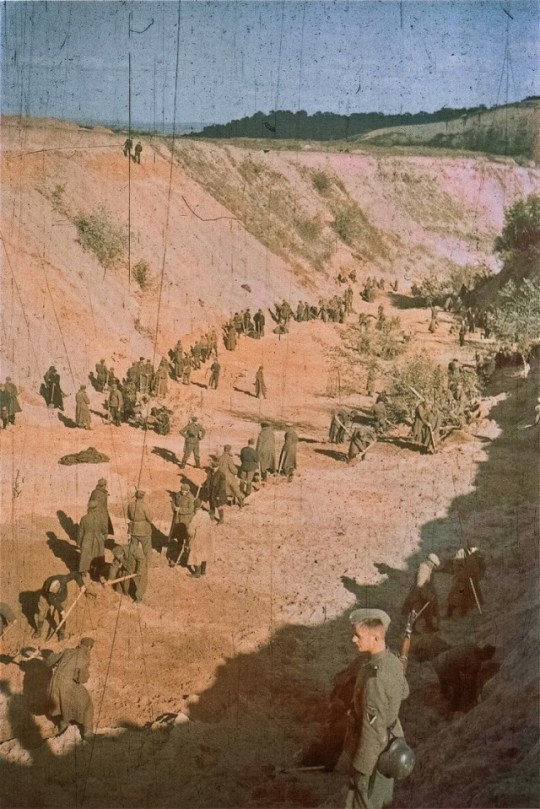
Des prisonniers de guerre soviétiques sont utilisés par les nazis pour recouvrir le charnier de Babi Yar - Ukraine - 1er octobre 1941
Photographe : Johannes Hähle
Dans le cadre de l'Opération Barbarossa, Kiev est conquise par la Wehrmacht le 19 septembre 1941. La ville est piégée de plus d'une dizaine de milliers de charges explosives et de mines actionnées par un commando du NKVD resté sur place. Le déluge de feu du 24 septembre fit des milliers de morts parmi les troupes allemandes.
Les juifs sont tenus pour responsables du chaos et le 28 septembre, un communiqué de l'administration nazie ordonne à tous les Juifs de Kiev et des environs (environ 120.000) de se présenter le lendemain, jour de Yom Kippour, munis de leurs papiers d’identité, d’argent, de leurs objets de valeurs, ainsi que de vêtements chauds, de linge, etc...
Le 29 septembre ils furent conduits au ravin de Babi Yar près de Kiev. Le ravin fait 150 mètres de longueur, 30 mètres de largeur et 15 mètres de profondeur. Les juifs traversent un corridor d'environ 1,5 mètre de large formé de soldats au coude à coude et de chiens, roués de coups de matraque et de bâton, puis forcés à se déshabiller et conduits au bord du ravin pour y être exécutés par les membres des Einsatzgruppen et des Ukrainiens nationalistes.
Environ 22.000 personnes sont tuées dès le premier jour, plus de 11.000 le deuxième jour. Les corps sont ensuite recouverts de terre par des prisonniers de guerre soviétiques. Jamais les nazis n'ont exterminés autant de monde en si peu de temps même dans les camps de concentration. Le massacre de Babi Yar est la plus grande extermination de juifs par balles : c'est la Shoah ukrainienne par balles.
Durant les deux années qui suivirent, près de 140.000 juifs, polonais, tsiganes, opposants aux nazis, malades mentaux, prisonniers de guerre, furent exécutés à la mitrailleuse ou enterrés vivants.
En août et septembre 1943, devant l'avancée des troupes russes, Paul Blobel à la tête du Kommando 1005 fait exhumer les corps pour les brûler et les faire ainsi disparaître.
Les autorités soviétiques ont effacé cette tragédie. La souffrance juive ne devait pas occulter la souffrance du peuple soviétique et le récit de la grande guerre patriotique. Le site a été remblayé dans les années 60 et accueille désormais un quartier résidentiel.
#WWII#Opération Barbarossa#Barbarossa Operation#Massacre de Babi Yar#Babi Yar massacre#Shoah#Babi Yar#Kiev#Kyiv#Ukraine#01/10/1941#10/1941#1941
9 notes
·
View notes
Text

“Lorsqu’on cherche à identifier en soi-même d’où vient cette stupidité, on s’aperçoit que ce sont la haine et la soif, ou désir – ces deux causes du samsâra -, ainsi que l’ignorance et les autres émotions négatives, qui sont nos ennemis intérieurs. Ces ennemis sont dépourvus d’un corps physique muni de bras et de jambes. Ils ne portent pas d’armure ni de casques ornés de drapeaux, et ne brandissent pas d’armes non plus. Ce ne sont pas de vaillants guerriers : ils ressemblent plutôt à des fainéants. Leur habileté à nous leurrer n’est pas pour autant un signe de ruse et d’intelligence : ils sont stupides […] Ces ennemis, qui n’ont d’autre domicile que notre esprit, s’y installent comme des voyageurs dans un temple. Non seulement ils nous asservissent à leur gré au désir, à la haine et aux autres émotions négatives, mais ils nous infligent aussi comme bon leur semble, sans retenue ni précaution, toutes sortes de maux dans cette vie et les suivantes. Supporter de tels ennemis sans s’irriter, c’est être patient avec un objet de patience qui ne le mérite pas, et ce genre de patience est méprisable aux yeux des bouddhas et des bodhisattvas.”
Kunzang Palden (1862-1943), Perles d’ambroisie, trad. Comité de traduction Padmakara, 2006.
3 notes
·
View notes
Text

. In late November 1943, stunt doubles from various studios posed for a publicity photo.
Top row (l to r): John Moss (Errol Flynn), Gino Corrado (Leo Carrillo), Paul Bradley (Ronald Colman), Roy Thomas (Spencer Tracy), Rodney Bell (Charles Laughton)
Center row (l to r): Linda Landi (Frances Langford), Pamela Drake (Veronica Lake), Mary Miner (Irene Dunne), Ezelle Poule (ZaSu Pitts), Margaret Bryson (Loretta Young), Elaine Waters (Mary Astor)
Bottom row (l to r): Len T. Brixton (Edward G. Robinson), Robert Katcher (Peter Lorre), Sydney Chatton (Paul Muni), Rod Rogers (James Cagney)
22 notes
·
View notes
Text

Les valises du docteur Petiot
Procès du Docteur Petiot, Mars 1946
«Au lendemain de la Seconde Guerre mondiale, Marcel Petiot,dit le docteur Petiot (1897- 1946), fut condamné à mort pour le meurtre de 27 personnes et guillotiné le 25 mai 1946 à Paris.
Depuis 1943, Marcel Petiot proposait à des personnes menacées par la Gestapo, principalement des juifs, des truands et des prostituées, de les faire passer clandestinement en Argentine. Les prétendants au voyage se rendaient chez lui la nuit, munis de leurs biens les plus précieux. Petiot faisait disparaître les corps de ses victimes dans l’acide et conservait leurs valises qui seront exhibées comme pièces à conviction»
Photographe anonyme
13 notes
·
View notes
Text
“It’s still hard:” Asian Americans Paving the Way in Hollywood By Jessica Pickens

The 2018 film CRAZY RICH ASIANS was a success in many areas. Based on the best-selling novel by Kevin Kwan, the film became the highest-grossing romantic comedy in 10 years. An August 2018 article in Time Magazine noted that the film would “change Hollywood.” CRAZY RICH ASIANS was the first film since THE JOY LUCK CLUB (’93) to have an all-Asian American cast or an Asian American lead role. Nearly 60 years before, the all Asian American cast of FLOWER DRUM SONG (��61) also hoped they were changing the way Asians were cast in Hollywood.
Since the silent era of films, Asian American actors have struggled to find quality roles and respect in Hollywood. Some, actors like Sessue Hayakawa and Anna May Wong, were frequently cast as vamps or villains — which in return put them in poor favor with Japanese and Chinese communities of their time. Miscegenation laws kept Asian American actors from having a romantic leading role with a white actor. In turn, Asians lost roles to white actors in yellowface, from Austrian actress Luise Rainer in THE GOOD EARTH (’37) to English actor Alec Guinness in A MAJORITY OF ONE (’61).
These actors helped fight and pave the way for the success of CRAZY RICH ASIANS:
Sessue Hayakawa

Today, actor Sessue Hayakawa is best recognized for his roles in THE BRIDGE ON THE RIVER KWAI (’57) and as the pirate in Walt Disney’s SWISS FAMILY ROBINSON (’60). But from 1915 to the early 1920s, Japan-born Hayakawa was one of the top silver screen idols of the silent era in the United States and Europe. He was as famous and recognizable as Charlie Chaplin or Douglas Fairbanks, according to his biographer Daisuke Miyao in the book Sessue Hayakawa: Silent Cinema and Transnational Stardom.
Fame followed Hayakawa after playing the lead in Cecil B. DeMille’s THE CHEAT (’15), in which he gives a financial loan to a wealthy woman (Fannie Ward). When she tries to back out of their bargain, he won’t take money as payment, but sexual favors. His character also brands Ward to signify that he owns her. THE CHEAT brought Hayakawa success, but it also brought typecasting. His resulting characters were usually dangerous, forbidden lovers or sexy villains. Hayakawa was criticized by the Japanese-American community for his roles. The Los Angeles-based Japanese American newspaper Rafu Shimpo said THE CHEAT “distorted the truth of Japanese people” depicting them as dangerously evil and would cause anti-Japanese movements.
Hayakawa eventually grew tired of the stereotypical roles he was cast in. In 1922, Hayakawa went to Europe where he performed in England and France. He stayed in Europe until after World War II and returned to Hollywood in 1949. Hayakawa was recognized for his role in THE BRIDGE ON THE RIVER KWAI with an Academy Award nomination for Best Actor in a Supporting Role.
Anna May Wong

She was rejected by China because she was “too American” and rejected in Hollywood because she was “too Chinese.” But Chinese American actress Anna May Wong achieved international fame by the mid-1920s, though she struggled with being stereotyped. Often cast as a vamp, sexual figure, slave or prostitute, the Chinese government said she played roles that demeaned China, and Graham Russell Hodges’ Anna May Wong: From Laundryman's Daughter to Hollywood Legend recalls how the Chinese media and government resented “having their womanhood so represented.”
When Wong campaigned for roles that could potentially change her image, like O-Lan in THE GOOD EARTH, she lost out to a white actor playing yellowface. In fact, the Chinese government worked against Wong being cast in THE GOOD EARTH. Hodges states how General Tu, MGM’s Chinese government advisor, told MGM that her reputation was bad in China and whenever she appeared in a film, newspapers printed that “Anna May loses face in China again.”
When white actor Paul Muni was cast as the male lead of THE GOOD EARTH, Wong knew she had missed her opportunity because of miscegenation laws. Wong supported China during World War II through the Red Cross, USO and China Relief efforts. She also wrote articles in China’s support and created a cookbook of traditional Chinese dishes. On the first anniversary of the Pearl Harbor attacks, she was sworn in as an air raid warden, according to Hodge’s book.
In 1943, the First Lady of the Republic of China, Madame Chiang Kai-shek, visited Hollywood. She gave a speech at the Hollywood Bowl and a luncheon was held. Madame Chiang Kai-shek was flanked by actresses like Marlene Dietrich and Loretta Young, but noticeably not Wong. Madame Chiang had specifically requested for Wong to be excluded from the events. Anna May Wong continued to act sporadically and died just before she was to co-star in the all Asian American cast of THE FLOWER DRUM SONG.
Keye Luke
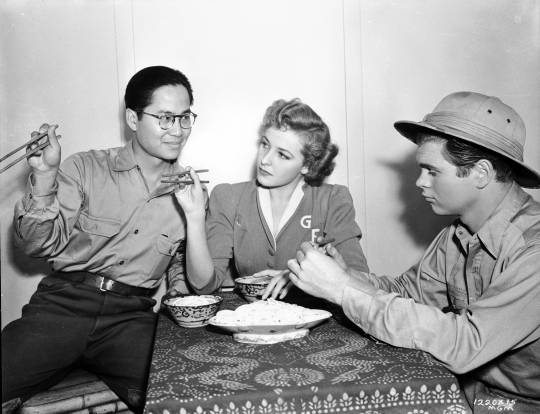
Chinese actor Keye Luke started in films in the 1930s, usually playing a mild-mannered, polite and intelligent young adult Asian male. Often, Luke played young physicians, like in THE PAINTED VEIL (’34), MAD LOVE (’35) and the Dr. Kildare and Dr. Gillespie film series. Luke became best known for his role in the 1930s as Lee Chan, the No. 1 son of detective Charlie Chan, who was played by white actor Warner Oland. The film series has since been criticized for perpetuating Asian stereotypes and having a white actor in the lead role, but Luke defended the films.
“How can they be criticized when the character was a hero,” Luke said in a 1986 Los Angeles Times interview. “People respected him. Police departments consulted with him and called on him to help them.” However, despite this, Luke and other Asians faced racism in Hollywood. Luke said in the 1930s that Los Angeles was “segregated, but not formally.” He was only hired when they needed a “Chinaman.”
“One never saw blacks on Wilshire Boulevard. Parts of the city I avoided–all white areas like Beverly Hills. Even after working with somebody like a big Caucasian actor, I’d be ignored if we met on the street. Asians were invisible, you see. We knew our place: One step back. That’s why the Charlie Chan films were so important. They deflated a lot of the current racial myths. But even the Chan films had rules. Charlie never touched a white woman except as a handshake. I’d never have a white girlfriend, not that I wanted one in pictures,” Luke said in an interview published in Conversations with Classic Film Stars: Interviews from Hollywood's Golden Era by James Bawden and Ron Miller.
After World War II, Luke found roles were harder to find, and many of his roles were uncredited. By the 1960s, more Asian actors were on the screen. In his interview with Miller, Luke joked that before the 1960s he and Korean actor Philip Ahn “divided the work.”
Philip Ahn
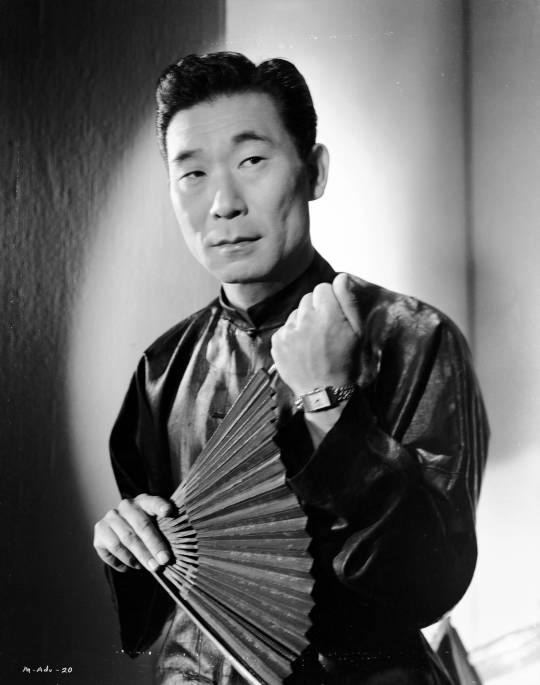
Philip Ahn was a Korean American actor who only played a Korean character once on film. In Hye Seung Chung’s Hollywood Asian: Philip Ahn and the Politics of Cross-Ethnic Performance, he details how before World War II, Ahn was promoted as a Chinese actor and often nicknamed the “Oriental Clark Gable.” During World War II, however, Hollywood shifted its publicity and focused on Ahn’s Korean ancestry. The publicity articles discussed Ahn’s father, Ahn Changho, who was an activist against the Japanese government. Ahn was also promoted as “the man we love to hate” and the “leering yellow monster.”
During the war, Ahn was frequently cast as a Japanese soldier in the 1940s, something he later said that he didn’t mind, as he felt he was contributing to his late father's legacy. Despite these characters not reflecting Ahn’s personality, Chung recalls how Ahn received hate mail from audiences who confused his onscreen characters for real life. In the 1953 Korean War film BATTLE CIRCUS, Ahn and his brother Ralph both played North Korean prisoners. Ahn said while he played many nationalities, this was the only time he played a Korean character, according to his 1978 The New York Times obituary.
Miyoshi Umeki

Japan-born Miyoshi Umeki was the first Asian to win an Academy Award for a performance. Umeki won Best Supporting Actress for her first Hollywood film, SAYONARA (’57). Though Umeki was the first Asian to win an Academy Award, this “first” isn’t often discussed. Despite the accolade, Umeki was still stereotyped in Hollywood. Her characters were generally demure, humble, delicate and subservient. Umeki’s characters spoke in broken English with a sweet smile.
Her son Michael Hood later asked her why she agreed to play these characters. “Her answer was very simple: ‘I didn’t like doing it, but when someone pays you to do a job, you do the job, and you do your best,’” Hood said in a 2018 Entertainment Weekly article. Umeki later threw away her Academy Award statue, according to Hood. As of 2020, Umeki is the only Asian female to win an Academy Award.
Nancy Kwan
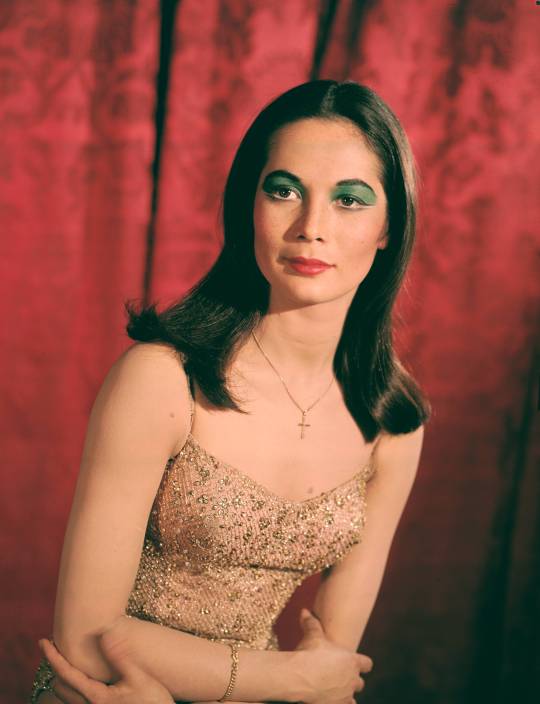
Hong Kong-born actress Nancy Kwan burst on to the film scene in 1960. She was cast as the lead in THE WORLD OF SUZIE WONG (’60) alongside one of Hollywood’s top actors, William Holden. Kwan was then cast in the all -Asian American cast of the Rodgers and Hammerstein film version of FLOWER DRUM SONG. With a strong start in films, a successful Hollywood career seemed likely for Kwan, but the roles weren’t there. William Holden told her, “You can do a big film and be very successful but in order to sustain a career, you have to have roles written for you,” Kwan shared in a 2018 NBC interview. Kwan was more successful than her predecessors, however, as Asians were starting to be cast rather than white actors in yellowface. Kwan was also cast in roles where she had white romantic leading men, like HONEYMOON HOTEL (’64) and THE WILD AFFAIR (’65). But Hollywood still didn’t know what to do with Kwan. She was cast in “exotic” roles like in the Walt Disney film LT. ROBIN CRUSOE, U.S.N. (’66) as an island girl. Kwan was offered a role in the film THE JOY LUCK CLUB, but she revealed in a 2018 interview at the TCM Classic Film Festival that she declined it because of a line criticizing SUZIE WONG. While she mentioned in a 1990 Los Angeles Times interview that “There are now many, many Asian actresses — but not many roles,” 18 years later she noted that the film industry had changed, but not enough. “There are more leading roles and not just small roles, but it’s still hard.”
#Asian American#Asians in Hollywood#Sessue Hayakawa#Anna May Wong#Philip Ahn#Miyoshi Umek#Keye Luke#Nancy Kwan#TCM#Turner Classic Movies#Jessica Pickens#classic hollywood
715 notes
·
View notes
Text

Gene Eliza Tierney (November 19, 1920 – November 6, 1991) was an American film and stage actress. Acclaimed as a great beauty, she became established as a leading lady. Tierney was best known for her portrayal of the title character in the film Laura (1944), and was nominated for an Academy Award for Best Actress for her performance as Ellen Berent Harland in Leave Her to Heaven (1945).
Tierney's other roles include Martha Strable Van Cleve in Heaven Can Wait (1943), Isabel Bradley Maturin in The Razor's Edge (1946), Lucy Muir in The Ghost and Mrs. Muir (1947), Ann Sutton in Whirlpool (1949), Maggie Carleton McNulty in The Mating Season (1951), and Anne Scott in The Left Hand of God (1955).
I Gene Eliza Tierney was born on November 19, 1920 in Brooklyn, New York, the daughter of Howard Sherwood Tierney and Belle Lavinia Taylor. She was named after a beloved uncle, who died young.[4][page needed] She had an elder brother, Howard Sherwood "Butch" Tierney Jr., and a younger sister, Patricia "Pat" Tierney. Their father was a successful insurance broker of Irish descent, their mother a former physical education instructor.[4][page needed]
Tierney was raised in Westport, Connecticut. She attended St. Margaret's School in Waterbury, Connecticut, and the Unquowa School in Fairfield. She published her first poem, entitled "Night", in the school magazine and wrote poetry occasionally throughout her life. Tierney played Jo in a student production of Little Women, based on the novel by Louisa May Alcott.
Tierney spent two years in Europe, attending Brillantmont International School in Lausanne, Switzerland, where she learned to speak fluent French. She returned to the US in 1938 and attended Miss Porter's School in Farmington, Connecticut. On a family trip to the West Coast, she visited Warner Bros. studios, where a cousin worked as a producer of historical short films. Director Anatole Litvak, taken by the 17-year-old's beauty, told Tierney that she should become an actress. Warner Bros. wanted to sign her to a contract, but her parents advised against it because of the relatively low salary; they also wanted her to take her position in society.
Tierney's society debut occurred on September 24, 1938, when she was 17 years old. page needed] Soon bored with society life, she decided to pursue an acting career. Her father said, "If Gene is to be an actress, it should be in the legitimate theatre." Tierney studied acting at a small Greenwich Village acting studio in New York with Yiddish and Broadway actor/director Benno Schneider. She became a protégée of Broadway producer-director George Abbott.
In Tierney's first role on Broadway, she carried a bucket of water across the stage in What a Life! (1938). A Variety magazine critic declared, "Miss Tierney is certainly the most beautiful water carrier I've ever seen!" She also worked as an understudy in The Primrose Path (1938).
The following year, she appeared in the role of Molly O'Day in the Broadway production Mrs. O'Brien Entertains (1939). The New York Times critic Brooks Atkinson wrote, "As an Irish maiden fresh from the old country, Gene Tierney in her first stage performance is very pretty and refreshingly modest." That same year, Tierney appeared as Peggy Carr in Ring Two (1939) to favorable reviews. Theater critic Richard Watts Jr. of the New York Herald Tribune wrote, "I see no reason why Miss Tierney should not have an interesting theatrical career – that is, if cinema does not kidnap her away."
Tierney's father set up a corporation, Belle-Tier, to fund and promote her acting career. Columbia Pictures signed her to a six-month contract in 1939. She met Howard Hughes, who tried unsuccessfully to seduce her. From a well-to-do family herself, she was not impressed by his wealth. Hughes eventually became a lifelong friend.
After a cameraman advised Tierney to lose a little weight, she wrote to Harper's Bazaar magazine for a diet, which she followed for the next 25 years. Tierney was initially offered the lead role in National Velvet, but production was delayed. page needed] When Columbia Pictures failed to find Tierney a project, she returned to Broadway and starred as Patricia Stanley to critical and commercial success in The Male Animal (1940). In The New York Times, Brooks Atkinson wrote, "Tierney blazes with animation in the best performance she has yet given". She was the toast of Broadway before her 20th birthday. The Male Animal was a hit, and Tierney was featured in Life magazine. She was also photographed by Harper's Bazaar, Vogue, and Collier's Weekly.
Two weeks after The Male Animal opened, Darryl F. Zanuck, the head of 20th Century Fox, was rumored to have been in the audience. During the performance, he told an assistant to note Tierney's name. Later that night, Zanuck dropped by the Stork Club, where he saw a young lady on the dance floor. He told his assistant, "Forget the girl from the play. See if you can sign that one." It was Tierney. At first, Zanuck did not think she was the actress he had seen. Tierney was quoted (after the fact), saying: "I always had several different 'looks', a quality that proved useful in my career."
Tierney signed with 20th Century-Fox[4][page needed] and her motion picture debut was in a supporting role as Eleanor Stone in Fritz Lang's western The Return of Frank James (1940), opposite Henry Fonda.
A small role as Barbara Hall followed in Hudson's Bay (1941) with Paul Muni and she co-starred as Ellie Mae Lester in John Ford's comedy Tobacco Road (also 1941), and played the title role in Belle Starr alongside co-star Randolph Scott, Zia in Sundown, and Victoria Charteris (Poppy Smith) in The Shanghai Gesture. She played Eve in Son of Fury: The Story of Benjamin Blake (1942), as well as the dual role of Susan Miller (Linda Worthington) in Rouben Mamoulian's screwball comedy Rings on Her Fingers, and roles as Kay Saunders in Thunder Birds, and Miss Young in China Girl (all 1942).
Receiving top billing in Ernst Lubitsch's comedy Heaven Can Wait (1943), as Martha Strable Van Cleve, signaled an upward turn in Tierney's career. Tierney recalled during the production of Heaven Can Wait:
Lubitsch was a tyrant on the set, the most demanding of directors. After one scene, which took from noon until five to get, I was almost in tears from listening to Lubitsch shout at me. The next day I sought him out, looked him in the eye, and said, 'Mr. Lubitsch, I'm willing to do my best but I just can't go on working on this picture if you're going to keep shouting at me.' 'I'm paid to shout at you', he bellowed. 'Yes', I said, 'and I'm paid to take it – but not enough.' After a tense pause, Lubitsch broke out laughing. From then on we got along famously.
Tierney starred in what became her best-remembered role: the title role in Otto Preminger's film noir Laura (1944), opposite Dana Andrews. After playing Tina Tomasino in A Bell for Adano (1945), she played the jealous, narcissistic femme fatale Ellen Berent Harland in Leave Her to Heaven (1945), adapted from a best selling novel by Ben Ames Williams. Appearing with Cornel Wilde, Tierney won an Academy Award nomination for Best Actress. This was 20th Century-Fox' most successful film of the 1940s. It was cited by director Martin Scorsese as one of his favorite films of all time, and he assessed Tierney as one of the most underrated actresses of the Golden Era.
Tierney then starred as Miranda Wells in Dragonwyck (1946), along with Walter Huston and Vincent Price. It was Joseph L. Mankiewicz' debut film as a director, In the same period, she starred as Isabel Bradley, opposite Tyrone Power, in The Razor's Edge (also 1946), an adaptation of W. Somerset Maugham's novel of the same name. Her performance was critically praised.
Tierney played Lucy Muir in Mankiewicz's The Ghost and Mrs. Muir (1947), opposite Rex Harrison. The following year, she co-starred again with Power, this time as Sara Farley in the successful screwball comedy That Wonderful Urge (1948). As the decade came to a close, Tierney reunited with Laura director Preminger to star as Ann Sutton in the classic film noir Whirlpool (1949), co-starring Richard Conte and José Ferrer. She appeared in two other film noirs: Jules Dassin's Night and the City, shot in London, and Otto Preminger's Where the Sidewalk Ends (both 1950), reunited with both Preminger and leading man Dana Andrews, who she appeared with in five movies total.
Tierney was loaned to Paramount Pictures, giving a comic turn as Maggie Carleton in Mitchell Leisen's ensemble farce, The Mating Season (1951), with John Lund, Thelma Ritter, and Miriam Hopkins. She gave a tender performance as Midge Sheridan in the Warner Bros. film, Close to My Heart (1951), with Ray Milland. The film is about a couple trying to adopt a child. Later in her career, she was reunited with Milland in Daughter of the Mind (1969).
After Tierney appeared opposite Rory Calhoun as Teresa in Way of a Gaucho (1952), her contract at 20th Century-Fox expired. That same year, she starred as Dorothy Bradford in Plymouth Adventure, opposite Spencer Tracy at MGM. She and Tracy had a brief affair during this time.[10] Tierney played Marya Lamarkina opposite Clark Gable in Never Let Me Go (1953), filmed in England.
In the course of the 1940s, she reached a pinnacle of fame as a beautiful leading lady, on a par with "fellow sirens Rita Hayworth, Lana Turner and Ava Gardner". She was "called the most beautiful woman in movie history" and many of her movies in the 1940s became classic films.
Tierney remained in Europe to play Kay Barlow in United Artists' Personal Affair (1953). While in Europe, she began a romance with Prince Aly Khan, but their marriage plans met with fierce opposition from his father Aga Khan III. Early in 1953, Tierney returned to the U.S. to co-star in the film noir Black Widow (1954) as Iris Denver, with Ginger Rogers and Van Heflin.
Tierney had reportedly started smoking after a screening of her first movie to lower her voice, because she felt, "I sound like an angry Minnie Mouse." She subsequently became a heavy smoker.
With difficult events in her personal life, Tierney struggled for years with episodes of manic depression. In 1943, she gave birth to a daughter, Daria, who was deaf and mentally disabled, the result of a fan breaking a rubella quarantine and infecting the pregnant Tierney while she volunteered at the Hollywood Canteen. In 1953, she suffered problems with concentration, which affected her film appearances. She dropped out of Mogambo and was replaced by Grace Kelly.[4][page needed] While playing Anne Scott in The Left Hand of God (1955), opposite Humphrey Bogart, Tierney became ill. Bogart's sister Frances (known as Pat) had suffered from mental illness, so he showed Tierney great sympathy, feeding her lines during the production and encouraging her to seek help.
Tierney consulted a psychiatrist and was admitted to Harkness Pavilion in New York. Later, she went to the Institute of Living in Hartford, Connecticut. After some 27 shock treatments, intended to alleviate severe depression, Tierney fled the facility, but was caught and returned. She later became an outspoken opponent of shock treatment therapy, claiming it had destroyed significant portions of her memory.
In late December 1957, Tierney, from her mother's apartment in Manhattan, stepped onto a ledge 14 stories above ground and remained for about 20 minutes in what was considered a suicide attempt. Police were called, and afterwards Tierney's family arranged for her to be admitted to the Menninger Clinic in Topeka, Kansas. The following year, after treatment for depression, she was discharged. Afterwards, she worked as a sales girl in a local dress shop with hopes of integrating back into society, but she was recognized by a customer, resulting in sensational newspaper headlines.
Later in 1958, 20th Century-Fox offered Tierney a lead role in Holiday for Lovers (1959), but the stress upon her proved too great, so only days into production, she dropped out of the film and returned to Menninger for a time.
Tierney made a screen comeback in Advise and Consent (1962), co-starring with Franchot Tone and reuniting with director Otto Preminger.[4][page needed] Soon afterwards, she played Albertine Prine in Toys in the Attic (1963), based on the play by Lillian Hellman. This was followed by the international production of Las cuatro noches de la luna llena, (Four Nights of the Full Moon - 1963), in which she starred with Dan Dailey. She received critical praise overall for her performances.
Tierney's career as a solid character actress seemed to be back on track as she played Jane Barton in The Pleasure Seekers (1964), but then she suddenly retired. She returned to star in the television movie Daughter of the Mind (1969) with Don Murray and Ray Milland. Her final performance was in the TV miniseries Scruples (1980).
Tierney married two men: the first was Oleg Cassini, a costume and fashion designer, on June 1, 1941, with whom she eloped. She was 20 years old. Her parents opposed the marriage, as he was from a Russian-Italian family and born in France. She had two daughters, Antoinette Daria Cassini (October 15, 1943 – September 11, 2010) and Christina "Tina" Cassini (November 19, 1948 – March 31, 2015).
In June 1943, while pregnant with Daria, Tierney contracted rubella (German measles), likely from a fan ill with the disease. Antoinette Daria Cassini was born prematurely in Washington, DC, weighing three pounds, two ounces (1.42 kg) and requiring a total blood transfusion. The rubella caused congenital damage: Daria was deaf, partially blind with cataracts, and severely mentally disabled. She was institutionalized for much of her life. This entire incident was inspiration for a plot point in the 1962 Agatha Christie novel The Mirror Crack'd from Side to Side.
It is claimed that she had an affair with Mohammad Reza Shah of Iran during the late 1940s.
Tierney's friend Howard Hughes paid for Daria's medical expenses, ensuring the girl received the best care. Tierney never forgot his acts of kindness. Daria Cassini died in 2010, at the age of 66.
Tierney and Cassini separated October 20, 1946, and entered into a property settlement agreement on November 10. Periodicals during this period record Tierney with Charles K. Feldman, including articles related to her "twosoming" with Feldman, her "current best beau". The divorce was to be finalized in March 1948, but they reconciled before then.
During their separation, Tierney met John F. Kennedy, a young World War II veteran, who was visiting the set of Dragonwyck in 1946. They began a romance that she ended the following year after Kennedy told her he could never marry her because of his political ambitions. In 1960, Tierney sent Kennedy a note of congratulations on his victory in the presidential election. During this time, newspapers documented Tierney's other romantic relationships, including Kirk Douglas.
While filming for Personal Affair in Europe, she began a romance with Prince Aly Khan. They became engaged in 1952, while Khan was going through a divorce from Rita Hayworth. Their marriage plans, however, met with fierce opposition from his father, Aga Khan III.
Cassini later bequeathed $500,000 in trust to Daria and $1,000,000 to Christina. Cassini and Tierney remained friends until her death in November 1991.
In 1958, Tierney met Texas oil baron W. Howard Lee, who had been married to actress Hedy Lamarr since 1953. Lee and Lamarr divorced in 1960 after a long battle over alimony, then Lee and Tierney married in Aspen, Colorado, on July 11, 1960. They lived quietly in Houston, Texas, and Delray Beach, Florida until his death in 1981.
Despite her self-imposed exile in Texas, Tierney received work offers from Hollywood, prompting her to a comeback. She appeared in a November 1960 broadcast of General Electric Theater, during which time she discovered that she was pregnant. Shortly after, 20th Century Fox announced Tierney would play the lead role in Return to Peyton Place, but she withdrew from the production after suffering a miscarriage.
Tierney's autobiography, Self-Portrait, in which she candidly discusses her life, career, and mental illness, was published in 1979.
Tierney's second husband, W. Howard Lee, died on February 17, 1981 after a long illness.[24]
In 1986, Tierney was honored alongside actor Gregory Peck with the first Donostia Lifetime Achievement Award at the San Sebastian Film Festival in Spain.
Tierney has a star on the Hollywood Walk of Fame at 6125 Hollywood Boulevard.
Tierney died of emphysema on November 6, 1991, in Houston, thirteen days before her 71st birthday. She is interred in Glenwood Cemetery in Houston.
Certain documents of Tierney's film-related material, personal papers, letters, etc., are held in the Wesleyan University Cinema Archives, though her papers are closed to the public.
21 notes
·
View notes
Text
Air Force
John Garfield in a publicity still for Air Force (1943). Howard Hawks did not want any established stars in the cast, fearing they would get in the way of realism. After seeing Paul Muni in Scarface, John was motivated to work with Hawks, so he convinced one of the Warner Brothers that casting a bankable star was smart business.

View On WordPress
1 note
·
View note
Text
Birthdays 9.22
Beer Birthdays
Lord Chesterfield; English statesman (1694)
Alfred Vinzenz Werthmueller (1835)
George Kennth Hotson Younger (1931)
Carlos Sanchez (1958)
Dave McLean (1969)
Five Favorite Birthdays
Bilbo Baggins; Hobbit character
Frodo Baggins; Lord of the Rings character
Michael Faraday; English scientist (1791)
Joan Jett; rock singer, guitarist (1958)
Tatiana Maslany; Canadian actor (1985)
Famous Birthdays
King Sunny Ade; Nigerian reggae singer (1946)
Scott Baio; actor (1960)
Toni Basil; pop singer (1943)
Shari Belafonte; actor (1954)
Debby Boone; pop singer (1956)
Harold Carmichael; Philadelphia Eagles WR (1949)
Nick Cave; rock musician (1957)
Ellen Church; 1st airline stewardess (1904)
Dave Coverdale; rock singer (1951)
Babette Deutsch; poet (1895)
John Houseman; actor (1902)
Bonnie Hunt; actor (1964)
Anna Karina; actor (1940)
Allan "Rocky" Lane; voice of "Mr. Ed" (1909)
Tommy Lasorda; Los Angeles Dodgers coach (1927)
Paul Le Mat; actor (1945)
Paul Muni; actor (1895)
Catherine Oxenburg; actor (1961)
Billie Piper; English singer, actor (1982)
Martha Scott; actor (1914)
Theodore Clement Steele; artist (1847)
Fay Weldon; English writer (1931)
0 notes
Photo
When Director Raoul Walsh wrote in his autobiography titled "Each Man in His Time" in 1974, in the book he described that Ida Lupino walked off with the best notices for her perforance in They Drive By Night (1940, Warner Brothers). Her mad scene in the courtroom . . . made her a star overnight. They Drive By Night combined the Paul Muni film Bordertown (1935, Warner Brothers) in which he co-starred with Bette Davis in the Ida Lupino role and was based on the A. I. Bezzerides’ novel about truckers titled The Long Haul (1938). Bezzerides’ first novel was based on his own experience as a truck driver in California’s fertile San Joaquin Valley, where he grew up. Warner Brothers offered him $2,000 for the screen rights plus he was offered a seven- year contract as a screenwriter. He took the job for $300 a week which got him working alongside author William Faulker for his first film, Juke Girl (1942, Warner Brothers) the film was about migrant farm workers which was filmed on location in Salinas, California which starred Ann Sheridan and Ronald Reagan. He wrote action films which included: Desert Fury (1947, Paramount) which was uncredited, Thieves Highway (1949, 20th Century Fox) which was based on his novel Thieves' Market, On Dangerous Ground (1951, RKO) and Kiss Me Deadly (1955, United Artists). Later in life, he wrote regularly for television, for such western series like Gunsmoke and Bonanza, was one of the co-creators of Barbara Stanwyck's, The Big Valley starting in 1965. A. I. Bezzerides died on January 1, 2007 in Los Angeles. Ida Lupino was a strong, convincing actress who for a brief period looked like a challenger for the Bette Davis crown at Warner Brothers. Indeed, she was diligently built up by the studio as a successor to to queen of the Warner lot. Ida Lupino was sometimes known as “the poor man’s Bette Davis” which meant, essentially, that she was offered first choice of roles if Davis refused them. During the 1940's Lupino had spectacular parts especially in The Hard Way (1943, Warner Brothers) for her performance as Helen Chernen she was awarded the New York Film Critics Circle Award for Best Actress. Ida Lupino was born on February 4, 1918 in Herne Hill, London and from the start she was destined for a theaterical career as her parents were actress Connie O'Shea (also known as Connie Emerald) and music hall comedian Stanley Lupino, her father, a top name in musical comedy in the United Kingdom and was a member of a centuries-old theatrical dynasty dating back to Renaissance Italy, he encouraged her to perform at an early age. While her paternal great- grandfather Alfredo Lupino was an acrobatic ballet dancer and singer, and her great-uncles were Mark and Harry who were stage headliners. Thus, it was assumed by her father that Ida's would follow in the family tradition in the theater. During the frequent absences of her parents when they were touring Ida was acquainted with the arts by her grandfather George, a semi-invalid who would go on to teach Ida how to sing, compose music, paint and to recite Shakespearean passages. When Ida was seven years old her beloved grandfather died and she was sent to school at Clarence at Hove, where she was abled to showoff her emerging talent by writing, producing and starring in her first play titled Mademoiselle. While back home she acted with her younger sister Rita (1920-2016) in improvished scenes which made her parents very happy. At the age of thirteen Ida enrolled at the Royal Academy Of Dramatic Arts where she acted in a series of student plays which included Pygmalion and Juluis Caesar. Ida's famous cousin Lupino Lane became her agent and helped gain her work as a screen extra at British International Studios. Ida Lupino's first big break came when she was cast as the ingenue in Her First Affair (1933, Sterling Films) directed by American Allan Dwan. Dwan later recalled that Lupino's mother Connie had originally tested for the part, and was accompained by her 14-year daughter where Connie and her agent went on how she would be good in the role but I noticed her daughter and I asked, "What about her - can she act?... That's whom I want - I want her." Well everybody was shocked since I was insisting on this girl who's mother came in for the role and finally they agreed and I got her. She was Ida Lupino and she was great. At the time Ida was a platinum blonde who was billed as "the English Jean Harlow" who received good notices for her performance. In July 1933, Ida signed a six month contract with Paramount Studios, which soon announced that Ida would star in these films: Money For Speed (1934, United Artists), I Lived With You (1933, Gaumont-British Picture Corporation Limited), Prince Of Arcadia (1933, Reginald Fogwell Productions), and The Ghost Camera (1933, RKO). Paramount thought of a plan to cast the young actress in the title role in Alice In Wonderland, but when Ida reported to Paramount for hair and make-up tests it was determined that Ida's sultry voice and sophisticated manner were totally wrong for the role of the innocent Alice. Ida Lupino was less of a tramp in Money For Speed (1934, United Artists) which starred John Loder after this she started making many films and out of all these films Search For Beauty was one of the better ones. Ida did have a good chance in One Rainy Afternoon (1936, United Artists) a satirical comedy starring Robert Young and Francis Lederer, then Paramount put her Yours For The Asking (1936, Paramount) starring George Raft. But it was Ida's fourth film for 1939, titled The Light That Failed (Paramount) which provided the strong-willed actress a role that she'd been waiting for since arriving in Hollywood. Her compelling screen test for director William Wellman convinced the studio to cast Ida as Bessie, a hot-tempered Cockney streetwalker. Ida received rave reviews, with Frank S. Nugent writing in the New York Times that Ida's performance as Bessie was, "another of the surprises we get when a diminutive ingenue bursts forth as a great actress." Lupino was so anxious to play the role, that she stole a copy of the script and stormed into director William Wellman's office demanding a chance to audition. Cast as a tart which gave the first indications that she might have talent. Warner Brothers thought so and signed her to a long-term contract and gave her the role of Alan Hale's floozy wife named Lana Carlsen in They Drive By Night (1940, Warner Brothers). Costarring were George Raft, Humphrey Bogart and Ann Sheridan, Ida was cast as the harpy wife whose love for truck driver Joe Fabrini (George Raft) which leads to murder and eventual madness. Ida was acclaimed for her performance and she was hailed for her "arresting performance." Next up Ida was assigned another fine part, opposite Humphrey Bogart and top-billed in High Sierra (1941, Warner Brothers), Ida's first film noir where critic William Whitebait said, "Ida Lupino gives us the best moll I have ever seen." Lupino had strong roles in The Sea Wolf and Out Of The Fog (both 1941 and both Warner Brothers), her last role for 1941 was on loan out to Columbia Pictures for the film Ladies In Retirement, she was the rigid housekeeper who murders her employer, a trashy ex-actress well played by Isobel Elsom, rather then seeing her two mental defective sisters put away in an lunatic asylum. Costarring with Ida was British actor Louis Hayward they had married on November 16, 1938 and divorced on May 11, 1945, The two had meet earlier in 1933, on the set of Ida's film Money For Speed (United Artists). When Ida married her second husband, Collier Young, a Columbia Studios executive who was a close personal friend of Ida's first husband Louis Hayward. They married on August 5, 1948 and they formed an independent company Emerald Productions, and would eventually work together on the production titled Not Wanted (1949). When director Elmer Clifton suffered a severe heart attack just a production began and was not able to complete the film Ida Lupino step in to direct the film almost in its entirety surprising all of Hollywood. As a producer Ida generously gave the sole directing screen credit to Elmer Clifton who died shortly after the release of Not Wanted. Not too long after the production company changed its name from Emerald to Filmaker but when Young signed a deal with RKO Studios, which had been recently sold to Howard Hughes and as a result Filmakers received much needed financial backing from RKO, but Ida and Young had to relinquish complete control to Hughes. This pretty much ended Ida Lupino's marriage to Collier Young and her affair with Howard Duff, they later married after Ida divorced Young on October 20, 1951 and just the next day married Duff. In June 1995, after several years of declining health, she was diagnosed with cancer and following a stroke a month later she died on August 3, 1977 at her Burbank home she was 77 years old.

Ida Lupino photographed by Scotty Welbourne, 1940
656 notes
·
View notes
Photo


Commandos Strike at Dawn (1942)
Country: USA Language: English Release Date: 30 December 1942 (USA) Director: John Farrow Writers: Irwin Shaw (screen play), C.S. Forester (story) Stars: Paul Muni, Anna Lee, Lillian Gish A gentle widower, enraged at Nazi atrocities against his peaceful Norwegian fishing village, escapes to Britain and returns leading a commando force against the oppressors. Cast Cast overview, first billed only: Paul Muni ... Eric Toresen Anna Lee ... Judith Bowen Lillian Gish ... Mrs. Bergesen Cedric Hardwicke ... Admiral Bowen (as Sir Cedric Hardwicke) Ray Collins ... Johan Bergesen Robert Coote ... Robert Bowen (as Flying Officer Robert Coote RCAF) Rosemary DeCamp ... Hilma Arnesen Alexander Knox ... German Captain Elisabeth Fraser ... Anna Korstad Richard Derr ... Gunnar Korstad Erville Alderson ... Johan Garme Barbara Everest ... Mrs. Olav Rod Cameron ... Pastor Louis Jean Heydt ... Karl Arnesen George Macready ... Schoolteacher Release Date: 30 December 1942 (USA) Also Known As: The Commandos Come at Dawn Filming Locations: Heals Rifle Range, Saanich, British Columbia, Canada Box Office - Gross $1,300,000 (USA) Filming Dates 20 July 1942 - 25 September 1942 Copyright Holder Columbia Pictures Corporation (original), U.S. Copyright LP11778, 7 January 1943 Copyright MCMXLII by Columbia Pictures Corp. (on print) Academy Awards, USA 1944 Nominated for Oscar Best Music, Scoring of a Dramatic or Comedy Picture Louis Gruenberg Morris Stoloff
1 note
·
View note
Text
17.
Destinacija: Dolpo. Ova mistična i izolirana regija na Himalaji do kraja 18. stoljeća pripadala je Tibetu, a i danas, iako formalno pod Nepalom, zbog prometne nepristupačnosti ostala je gotovo zarobljena u vremenu; većina stanovnika i dalje govori tibetanski, a religija koja se prakticira je Bon, peta škola tibetanskog budizma. Sve do 1974. godine regija je bila zatvorena za turiste zbog sumnji da se tu skrivaju tibetanski Khampe - pobunjenici koji se bore za slobodni Tibet. Nepal je 1956. priznao Tibet kao dio Kine, a 1960. potpisao o sporazum o miru i prijateljstvu s Kinom, pa im je itekako bilo u interesu držat stvari pod kontrolom, posebno u osjetljivim graničnim područjima. Zbog svega ovoga, Dolpo je danas tzv. restricted area, koju se smije posjetit isključivo s dozvolom te uz vodstvo licenciranog nepalskog vodiča. Popularnost među zapadnim turistima je stekao nakon knjige ‘The Snow Leopard’ Petera Matthiessena iz 1978. i filma ‘Himalaya’ Érica Vallija koji je 1999. bio nominiran za Oscara, ali je unatoč tome i dalje jedna od najrjeđe posjećenih treking destinacija na Himalaji. Zašto? Jer je skupo ić s agencijom, jer je komplicirano organizirat trek sam, jer je fizički i psihički zahtjevno.
Do Dolpa se može doć na dva načina: avionom preko Juphala direktno (skupo!) ili pješke - uzduž himalajskog masiva zapadno od Benija, preko lovačkog rezervata Dhorpatana, pa sjeverno preko Himalaja. Kako nemamo baš dolara na bacanje, ali vremena za hodanje imamo, izabrali smo naravno potonje. Ova naša mala putešestvija trajala je sve skupa 21 dan, tako da sam je podijelila u dva dijela: trek do Dolpa, i trek po Dolpu. Pa da počnemo:
Dan 1
Krenuli smo iz Pokhare 28.5. prvim jutarnjim busom prema Muni. Pršanjavih 111 km prelazili smo nekih 5 sati, uz povremeno mijenjanje autobusa na mjestima gdje je trebalo preć rijeku, jer su tamo postojali samo viseći čelični pješački mostovi - isti oni kakve smo viđali iznad sebe raftajući po Karnaliju. Naši jadni ruksaci koji su se cijelo vrijeme vozili na krovu autobusa, nakon ove vožnje izgledali su ko da su prošli kroz pješčanu oluju, a ni mi koji smo sjedili unutra nismo bili pošteđeni fine prašine koja se u suradnji s obilnim znojenjem ubrzo zacementirala na našoj koži. Muna je zasad zadnja točka dokle se može doć autobusom, jer dalje cesta nije izgrađena. Kad kažem cesta, mislim na grubi kameni zastor koji će možda jednog dana postat makadam, a u nekoj dalekoj budućnosti se možda čak i asfaltira! Od Mune (+1943 mnv) nas je čekalo još 2 sata laganog hoda do Lumsunga (+2150 mnv), malog sela na obronku planine. Za prvi dan laganini! Ipak, sjećam se neugodnog osjećaja u želucu kad smo izašli iz autobusa, osjećala sam takvu nervozu… nesigurna u sebe i vlastite sposobnosti, s obzirom da se nikad nisam upustila u nikakav slični podhvat. Ruksak mi teži 20 kg, i ne mogu si psihički predočit da ću ga morat nosit svaki dan, cijeli dan, iduća tri tjedna. Štapovima za hodanje unatoč, i dalje osjećam bol u koljenima, jer već godinama patim od artroze… i pitam se koliko je ovo sve pametno. No dobro, sad nema povratka! Tojest ima, jer platili smo skupo osiguranje koje uključuje evakuaciju helikopterom iz Himalaja (da, extra stavka, i ne baš jeftina), i još uvijek se tješim mogućnošću da, ako mi bude preteško, u prvom selu uzmemo portera (jeftinija varijanta) ili mulu (skuplja varijanta). Ali krenuli smo! Oblačno je ali lijepo, još uvijek smo nisko i okruženi smo zelenim obroncima sa svih strana. Naš guide Lal riješio nam je da prvu noć spavamo u homestayu, u drvenom potkrovlju, šta je izvrsna tranzicija između civilizacije u kojoj smo bili zadnjih tjedan dana, i divljine u koju se tek spremamo ić. Iskoristili smo prigodu da se otuširamo polijevajući se ledenom vodom, koja je do kuće bila dovedena šlaufom iz obližnjeg potoka. Na ovakav luksuz nećemo još dugo nabasat!

Slika 1: Luka i Lal spremaju našu prtljagu na krov autobusa u Pokhari

Slika 2: Radovi na cesti - ovu dionicu smo prohodali

Slika 3: Ništa strojevi, samo ručni rad!

Slika 4: Počelo je! Uspon do Lumsunga
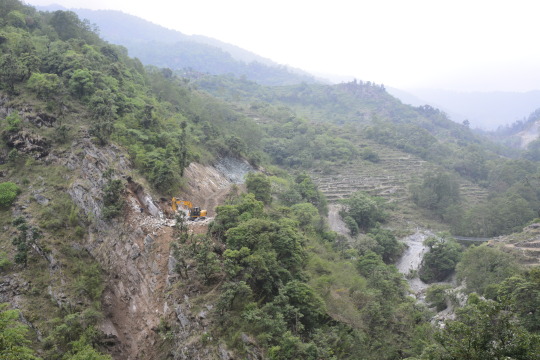
Slika 5: Na brdu prekoputa, bager probija novu cestu
Dan 2
Samo dva sata hodanja jučer su nas ubila, od opterećenja i trenja ruksaka počeli smo dobivat rane na kukovima i iznad guzice. Nismo se još baš ušemili u cijelu priču i ujutro smo tromi, treba nam sto godina da se složimo, spakiramo, pojedemo i budemo spremni za pokret. Danjeg svjetla ima do 6 popodne pa ćemo se ubuduće morat ustajat ranije, oko 6 ujutro, da bi već oko 8 krenuli hodat. Pred nama je naporan dan - 1200m čistog uspona, bez stajanja, po terenu gdje se izmjenjuju kamenjar, obrađena polja koja me neumoljivo podsjećaju na sjeverni Vijetnam, i guste šume rododendrona koji je upravo u cvatu. Naš guide je rodom iz ovog kraja, njegovo selo Gurjakhani je udaljeno 10-ak km zračne linije odavde, a poznato je po lovu na psihodelični med. Gigantske pčele na velikim nadmorskim visinama oprašuju cvijet rododendrona koji u sebi sadrži kemikaliju grayanotoxin, zaslužnu za halucinogena svojstva ovog divljeg meda. Naravno da ga želimo nabavit i probat, Lal nam kaže da možda uspijemo nešto riješit po tom pitanju kad završimo s trekom :)

Slika 6: Terasasti uzgoj

Slika 7: Nadrealna šuma rododendrona

Slika 8: Luka i rododendroni u cvatu
Nakon 6 sati pentranja, iscrpljeni i gladni prelazimo naš prvi prijevoj Jaljala (+3365 mnv) i stižemo na proplanak u alpskom stilu. Tu nas čeka stado divljih konja, i jedna kamena koliba - sezonska gostiona za putnike namjernike. Sa sjevera nas kroz oblake sramežljivo gleda Dhaulagiri Himal, 120 km dugačak planinski lanac kojeg ćemo idućih tjedan dana zaobilazit da bi došli u Dolpo. Jedan od njegovih vrhova, Dhaulagiri I, je sa svojih 8167 metara sedmi najviši vrh na svijetu. Nažalost, vrijeme je preoblačno da bismo ove impoznatne gromade uspjeli sagledat u svoj njihovoj ljepoti, ali bit će za to još prigoda narednih dana.
Lal je riješio da za ručak dobijemo instant noodle, a za večeru - a šta drugo nego dal bhat. Uz rub livade, pokraj potoka, podigli smo naš lijepi novi brlog - mali narančasti šator koji smo kupili u Kathmanduu. Šator ima samo 2 kg i zbilja je minijaturan, tako da smještaj dvije osobe i dva velika ruksaka predstavlja izazov; do kraja treka ćemo se već ispraksirat u tom tetrisu!

Slika 9: Konji pasu na lower Jaljala
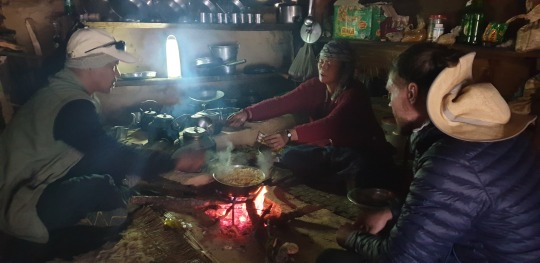
Slika 10: Unutrašnjost bhattija. Kuhaju se instant noodli

Slika 11: Pastir i njegovo stado u prolazu. U pozadini naš brlog :)

Slika 12: Gazda od bhattija s ukočenim vratom
Dan 3
Bilo je pitanje vremena kad će se neko od nas dvoje razbolit. Ja sam kronični sinusni bolesnik pa je red da prva obavim tu dužnost. Fala bogu lijekova nam ne fali, i tako počinjem udarat po Doksiciklinu. I gazda gostione je bolestan - ukočen mu je vrat, i tu Luka nastupa kao druid pa mu masira vrat deep heatom kojeg smo kupili u Vijetnamu. Kremu smo mu ostavili jer imamo još par sličnih, i krećemo dalje. Sad samo nizbrdo uz korito rijeke Uttar Ganga do Dhorpatana, sela smještenog na najvećoj visoravni na Himalaji. Opet je oblačno i maglovito a nije ni čudo, jer je kraj svibnja i monsunska sezona je pred vratima. Prvo naselje kroz koje smo prošli je Gurjakhat, gdje smo na naše veliko čuđenje ugledali - motor! Do dhorpatanske doline se naime može doć i jeepom iz Baglunga, šta me na trenutak obradovalo jer to znači da još uvijek imam šansu odustat od ove avanture ako zaključim da mi je preteško. Uskoro smo stigli do ogromnog proplanka omeđenog borovom šumom, konji pasu posvuda, sunčano je, idila.

Slika 13: Pratimo rijeku Uttar Gangu

Slika 14: Iako je oblačno, lijepo je

Slika 15: Prešli smo bezbroj ovakvih ‘mostova’

Slika 16: Dhorpatan valley, raj za konje

Slika 17: Dhorpatan, ziđa se. Ova nonica nosi više nego Luka i ja zajedno!
Oko 4 popodne eto nas u Dhorpatanu i tu sad treba obavit formalnosti s organima reda - pokazat dozvole za treking i platit upad u lovački rezervat. Ovo sve je potrajalo pa se žurimo dalje, da stignemo prije mraka. Da nas malo ubrza, počela je padat i kiša, i tako se sad ogrnuti kabanicama penjemo nekih 200 m do Bhujekhunga (+3103 mnv), zaseoka s dvije kuće, od kojih je jedna gostiona. Iako dan nije bio ni približno naporan kao jučerašnji, mrtvi smo umorni i pokisli i rado bismo izbjegli podizanje šatora. Lal je pitao možemo li spavat u gostioni ali avaj! Nemaju dovoljno mjesta za sve nas. Kako, šta, zašto? Radi se naime o slijedećem fenomenu:
Svake godine u svibnju i lipnju, horde Nepalaca napuštaju svoje domove, poslove, škole, spakiraju prnje i krenu u Himalaju okušat sreću u lovu na yarsagumbu; to je parazitska gljiva koja napada larvu moljca, klija u njoj, ubije je i mumificira te joj potom naraste iz glave - ne velika, samo par centimetara. Raste na Himalaji na nadmorskim visinama između 3500 i 5000 metara, odakle se otprema ponajviše u Kinu, koja je najveći konzument ove čudne gljive. Yarsa se konzumira osušena i samljevena, a uz mnoge druge zdravstvene dobrobiti koje joj se pripisuju navodno i pojačava libido, zbog čega je zovu još i ‘himalajska viagra’. U Kini jedan kilogram trenutno doseže cijenu od 110.000$ pa onda nije teško zamislit zašto tisuće ljudi biraju provest po mjesec dana kampirajući tu po planini, klečući i čeprkajući po vlažnoj travi u nadi da će iskopat koju gljivu i malo si popravit financijsku situaciju. Nepalski gold rush!
Nama s jedne strane super, jer to znači pod a) da ćemo svjedočit jedinstvenom kulturnom fenomenu, i pod b) da će svugdje na našem putu postojat bhatti - sezonski šatori - gostione i prenoćišta za ove diggere, gdje mi možemo pojest dal bhat. S druge strane, to znači i da je cijena istog tog dal bhata skočila u nebo, kao i da za nas nema mjesta za spavanje i da se moramo snać. To nas puno ne dira jer nam je ionako draže stiskat se u našem malom šatoru nego u bhattiju na tepihu koji smrdi po neopranim nogama.
U blizini kuće nalazi se jedna mala napuštena kamena štala, i Luka i ja smo odlučili složit si unutra brlog. Imamo krov nad glavom, zapalili smo vatru, kuha se juhica. Može li bolje? Može! Samo desetak metara od kućice nalazi se izvor, lijepo uređen i ograđen kamenjem tako da čovjek može doć i sjest, i komotno oprat šta god treba (zube, noge, suđe). Sapienti sat.

Slika 18: U našem malom brlogu u Bhujekhungu
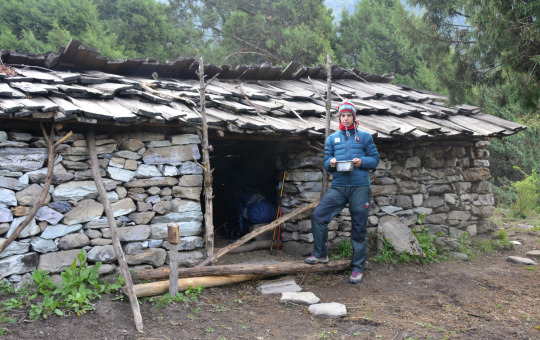
Slika 19: Ispred brloga

Slika 20: Praktični izvor pokraj kućice

Slika 21: Gazda od bhattija se sunča, a žena radi. Sve je isto kao kod nas
Dan 4
Za doručak chapati (pogača) i kajgana, ne tako loš obrok u usporedbi s dal bhatom koji mi već izlazi na uši, ali kako ulazimo dublje u planine, tako jaja postaju sve skuplja i skuplja i uskoro će nam postat pravi luksuz. Nije da ne bi rađe jeli zobenu kašu, ali nje imamo u ograničenim količinama i čuvamo je za prigode kad neće bit nikakve gostione u blizini i morat ćemo se oslanjat isključivo na vlastite zalihe hrane.
Pred nama je skoro 1000 metara uspona do prijevoja Phalgune Dhuri (+4067 mnv), i već vidim da će dan bit dug. Usput srećemo neke klince koji skakuću s kamena na kamen, bez tereta na leđima, zatim mlade Yarsaše koji neopterećeno jašu na svojim mulama (jedan od njih me upitao: Can you?, vidjevši valjda dobru prigodu da nam iznajmi koju mulu i zaradi kintu, na šta sam ja spremno odgovorila: Yes we can! Ne znam jesam li ga uspila uvjerit - sebe skoro pa jesam). Sreli smo i čitavu šesteročlanu familiju koja, skupa sa svojim bivolima, isto ide u lov na yarsu. Uskoro prelazimo granicu rasta drveća i pred nama je samo kamena pustinja i tek pokoja travka. Na prvu je očaravajuće, ima nešto privlačnog u tom ambijentu lišenom intenzivnih vizualnih podražaja. Ipak, mislim da bi me dugoročni boravak na ovakvom mjestu bacio u težu depru. Najveći problem je kad mi se pripiša da nemam di to obavit diskretno, nema stabla, žbuna ili kamena iza kojeg bi se sakrila, a planina vrvi ljudima (upravo zbog ovog Lonely Planet sugerira curama da na trek obuku - suknju).
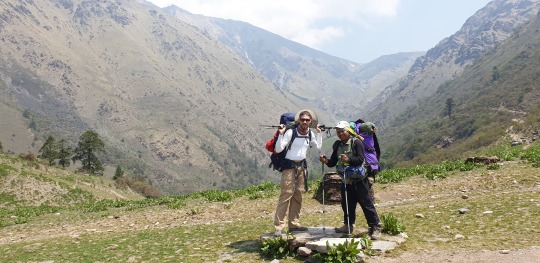
Slika 22: Luka i Lal na usponu za Phalgune Dhuri
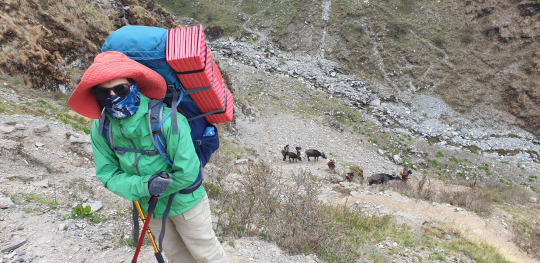
Slika 23: Prati nas familija Yarsaša
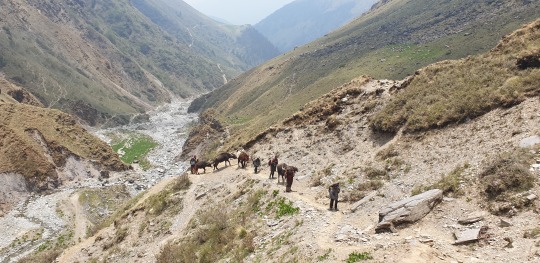
Slika 24: Uskoro su nas i sustigli
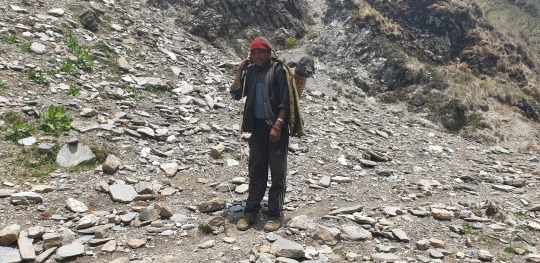
Slika 25: Mlado govedo bivola je premlado za hodanje pa ga gazda nosi u košari

Slika 26: Malo pomalo smo ostali bez stabala
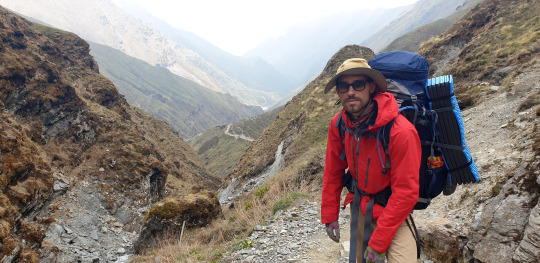
Slika 27: Tužni Luka je tužan. Možda mu fale stabla?

Slika 28: Vrijeme je za marendu

Slika 29: White-capped water redstart - jedini wildlife zasad
Na vjetrovitom prijevoju pojeli smo marendu i krenuli se spuštat. Do Thankura, gdje ćemo provest noć, ima malo manje od 800 metara nizbrdo. Na papiru zvuči super, ali ko god je ikad imao problema s koljenima, zna koliko su nizbrdice naporne. Čim smo krenuli, pojavila su se opet stabla rododendrona a s njima se i moje raspoloženje popravilo. Predvečer smo stigli u Thankur (+3190 mnv), predivnu zelenu dolinu sa svih strana okruženu planinskim vrhovima i borovom šumom. U dolini se nalaze 3 kamene kuće, naravno sve dupkom pune Yarsaša, a po rubu teče rijeka Sai Khola optočena mahovinom pokraj koje smo digli šator, taman kad je krenula padat kišica. Spavat je bilo divno, iako ledeno i vlažno.

Slika 30: Mule marendavaju na maglovitom prijevoju Phalgune Dhuri

Slika 31: Rododendroni

Slika 32: Idilična dolina Thankur

Slika 33: Naš brlog
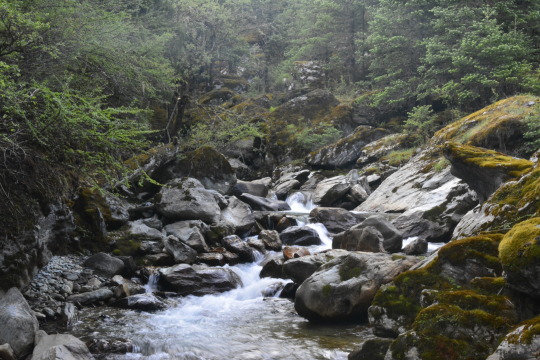
Slika 34: Mistična rijeka Sai Khola

Slika 35: Gusta okolna šuma

Slika 36: Kuha se u bhattiju, nigdje dimnjaka
Dan 5
Dok smo pakirali prnje i sušili šator na prvim zrakama sunca, društvo nam je pravio znatiželjni dječak sa svojim malim janjetom. Kao i svako dosad, jutro je lijepo i sunčano, a za pretpostavit je da će se do navečer navuć oblaci. Počeli smo s laganim spuštanjem do pitoreskne rijeke Ghasdung Khole, nakon kojeg nas je čekao uspon od 440m, i to većinom uređenim stazama sa stepenicama koje su izgrađene da lovcima (uglavnom Rusima) olakšaju kretanje rezervatom. Tu i tamo pokraj staze naiđemo i na jednostavno drveno sklonište. Životinje koje obitavaju u ovim krajevima su himalajski tahr (divokoza), crni medo, crvena panda, himalajski bharal (blue sheep) i samozatajni snježni leopard koji je ugrožena vrsta i zabranjeno ga je lovit (makar realno, šanse da ga netko opazi u prirodi su ravne nuli). Nismo vidili nijednu od ovih životinja, ali smo zato prošli pokraj mnogih polja marihuane, finog himalajskog skanka koji se uzgaja tu bogu iza nogu, daleko od nepoželjnih očiju.

Slika 37: Sušenje šatora na jutarnjem suncu

Slika 38: Klinac i mlada janjetina
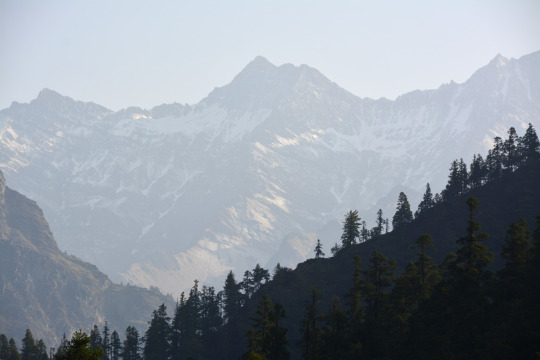
Slika 39: Surovi vrhovi
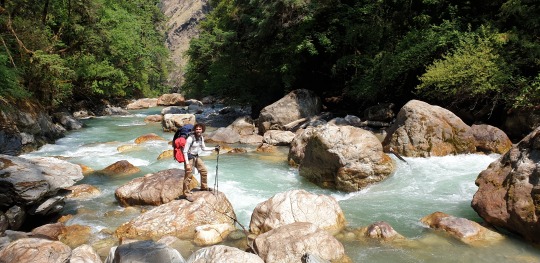
Slika 40: Luka i rijeka Ghasdung Khola

Slika 41: Polja marihuane
Na kraju uspona, u malom seocetu Kayam (+2890 mnv) smo ručali instant noodle i potom krenuli dalje nizbrdo na drugu stranu. Prvi dio puta nas je pratilo troje klinaca iz Kayama koji su išli u susjedno selo prespavat da bi sutra ujutro mogli ić na misu. Misu! Znači u ovoj vukojebini postoji ni manje ni više nego - crkva. Skromna doduše, ali svejedno je impresivno da je kršćanstvo doprijelo ovako duboko u Himalaju. Nakon crkve uslijedilo je novo iznenađenje - dalekovodi!. Dakle ima i struje. Malu hidroelektranu nažalost nismo vidjeli jer nas je put odveo na drugu stranu u Tatopani (+2397 mnv), zaseok s par kamenih kuća. Tatopani u doslovnom prijevodu s nepalskog znači topla voda, a ime je dobilo po izvorima vruće vode kojih u okolici ima nekoliko. Na izvorima je sve krcato Yarsašima koji peru sebe i odjeću, i mi jedva čekamo da i na nas dođe red. Situacija je nezgodna jer sam cura i očekuje se da budem čedna pa se moram zamotat u sarong i tako prat. Nije to neko temeljito pranje (mislim, teško se oprat dok si ODJEVEN), ali bolje išta nego ništa - nakon 5 dana prašinarenja!
Yarsaši imaju svoje DIY šatore - lučna konstrukcija od bambusa i pokrov od cerade, pa tako ovog puta za nas ima mjesta da spavamo u kući, ali nije to ništa fancy, samo smrdljivi tepih na zemljanom podu. Iako preferiramo svoj mali narančasti brlog, ponekad nam ipak dobro dođe da uštedimo tih sat i po vremena koliko bi potrošili na sastavljanje i rastavljanje šatora.
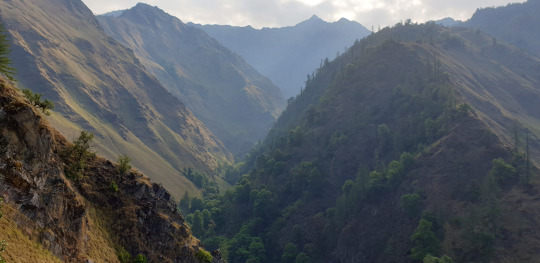
Slika 42: Strmi obronci prema Tatopaniju

Slika 43: Pogled na Tatopani s brda
Dan 6
Pred nama je dug dan - u dogovoru s guideom smo spojili dva dana hodanja u jedan, da bi malo uštedili na vremenu i priuštili si dan odmora nekad kasnije na treku. To znači da smo se ustali rano i krenuli rano, ne bi li stigli na odredište prije mraka. Oblačno je, maglovito i hladno, a nas čeka 1500 metara uspona. Danas ima nenormalno puno Yarsaša po putu, posvuda su i ostavljaju smeće iza sebe, uglavnom ambalažu od instant noodli i Red Yaka - kineske kopije Red Bulla. Ponešto od toga kupimo sa sobom, ali to je već izgubljena bitka, jer njih je previše i njihovog smeća je previše, a mi imamo ograničene kapacitete u ruksacima. Tužno, uz toliko diskusije o tome koliko je treking uopće environmental - friendly, da su najveći zagađivači upravo lokalci. Po pitanju smeća, sve je isto ko u Vijetnamu, ako ne i gore.
Putem smo prošli kroz selo u kojem smo vidili nekoliko kuća s ravnim krovovima, što je uvjerljivi znak da se približavamo Dolpi, gdje je ravni krov pravilo, a ne iznimka (ovaj podatak sam saznala iz Snow leoparda, kojeg smo kupili u Kathmanduu i sad ga na treku čitam). Ručali smo instant noodle u bhattiju u selu Dhule (+3340 mnv) i brzo krenuli dalje da nas ne uhvati mrak. Uskoro smo se opet popeli u zonu bez drveća, u kojoj ćemo ostat nekoliko dana. Počela je kišica a mi smo sve sporiji i sporiji, gladni smo i iscrpljeni. Hodamo u formaciji: Lal na početku, i u pravilu puno brži od nas jer ima manji ruksak, onda ja, i iza mene Luka koji povremeno ronza jer sam prespora, ali uglavnom me bodri da nastavim dalje. Naše odredište je Phudal Phedi (+3899 mnv), mali plac za kampiranje pokraj rijeke Sen Khole, na koji smo došli po debelom mraku. Nabrzaka smo digli šatore i skuhali večeru te se brže bolje spremili za spavanjac. Ovu noć sam provela u vreći za spavanje obučena u doslovno SVU odjeću koju sam imala sa sobom, toliko je hladno bilo.

Slika 44: Ravni krovovi koriste se kao spremišta i mjesta za druženje

Slika 45: Himalajski stil košnica

Slika 46: Riskantan prijelaz mostića na mjestu di se staza urušila
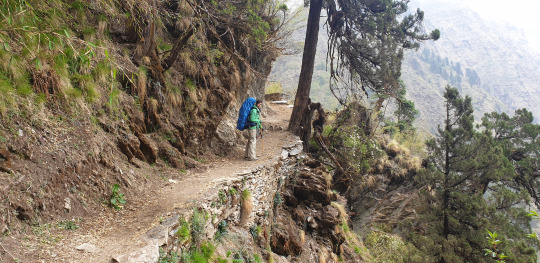
Slika 47: Staza prema Sen Kholi

Slika 48: Usamljeni planinar
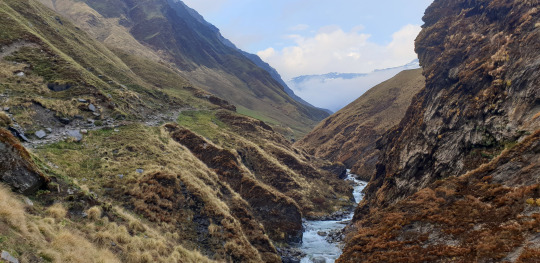
Slika 49: Rijeka Sen Khola u pustom ali impresivnom pejzažu

Slika 50: Sušenje suđa na zubatom jutarnjem suncu
Dan 7
Spavali smo malo duže, probudili se tek u 7, ali ni to nije pomoglo da se danas osjećamo odmorno. Iz kampa smo krenuli kasno i vucaramo se, mene boli kičma pa sam na brufenima, a sad već hodamo na visinama preko 4000 metara i zrak je rijeđi i samim time nam je sve teže. Jedna od stvari koje me muče je strah od visinske bolesti - o njoj smo pročitali puno i poduzimamo sve mjere opreza: jedemo puno ugljikohidrata i češnjaka, ne pijemo alkohol i ne spavamo na visinskim razlikama većima od 500 metara u odnosu na prethodnu noć. Imamo i tablete Diamoxa spremne ako zatreba. Ali opet, jednom hipohondru poput mene teško je ne trtarit.
Malo prije nego ćemo preć prijevoj Panidal La (+4502 mnv) naišli smo na veliki šareni kamp Yarsaša i dobili priliku vidit uživo kako izgleda ta famozna gljiva: mala, narančasta, ništa posebno. U kampu postoji par ljudi koji otkupljuju yarsagumbu od tragača i onda je na licu mjesta četkaju i razvrstavaju po veličini. Ovi ljudi vjerojatno spavaju na smjene i čuvaju svoje blago, jer je prošlih godina u kampovima znalo bit slučajeva krađe, pa čak i ubojstva. Na kojem god kraju svijeta se nalazili, pohlepa od ljudi uvijek napravi čudovišta.

Slika 51: Kostoberina - strvinar na visini zadatka

Slika 52: Šareni kamp Yarsaša

Slika 53: Yarsagumba se suši i razvrstava po veličini

Slika 54: Pustoš i magla
Prijevoj je točkasto prekriven snijegom, puše i ledeno je. Gdje nema snijega, tu je osušena kratka žuta trava. Nakon brzinskog ručka na vjetrometini krenuli smo dalje, prvo 500 metara nizbrdo, a onda 300 metara uzbrdo, da bi u podnožju brda ispred sebe ugledali ni manje ni više nego - vrtuljak! Iscrpljenom i gladnom čovjeku ovo možda izgleda kao halucinacija, ali vrtuljak je zbilja tu, metalni i zarđali. Izgleda kao da se već neko vrijeme ne koristi, a guide nam je reko da su ga tu rastavljenog, na mulama, dofurali za Yarsaše, koji jednom kad nađu koju gljivu i zarade pare, žele te pare i potrošit, malo se zabavit. Nadrealno ili ne, pitanje je hoće li itko ikad rastavit taj vrtuljak i odnit ga ća, ili će samo poslužit kao baza za bacanje drugog otpada.

Slika 55: Nadrealni prijevoj Panidal La

Slika 56: Spust prema rijeci Saure Kholi

Slika 57: Vrtuljak na +4000 mnv
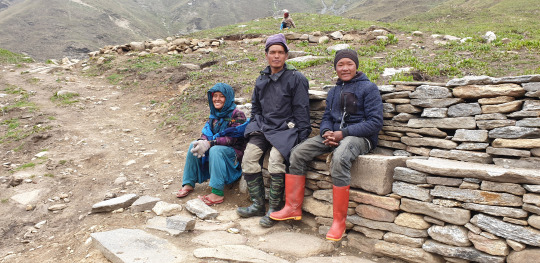
Slika 58: Yarsaši odmaraju na zidiću

Slika 59: Pogled u beskraj
Oko 6 i po navečer stigli smo napokon na Purbang (+4309 mnv) gdje nas je dočekao ogromni kamp Yarsaša. Sve je puno konja koji okolo slobodno trče i pasu, mladi dečki igraju odbojku na improviziranom terenu... imaju čak i policijski šator! Policija je tu da se brine za red i mir, da ne bi bilo krađa i svađa. Koliko god mi je draže kampirat na miru i osami, ovo ipak izgleda fora, i svi ti šareni šatori daju dozu šarma dramatičnoj podlozi golih snježnih vrhova. I dalje je ledeno pa vrijeme izvan šatora provodimo koliko je minimalno moguće, i idemo spavat odma nakon večere.
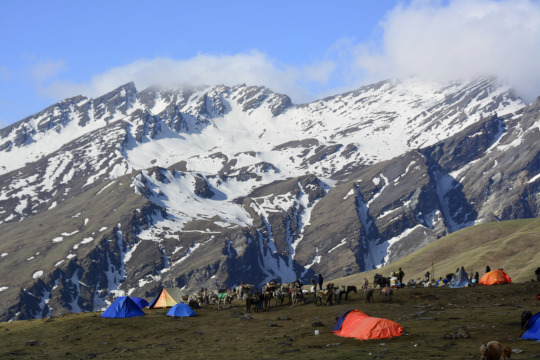
Slika 60: Kamp yarsaša na Purbangu

Slika 61: Zaljubljene mule

Slika 62: Odbojka u kampu
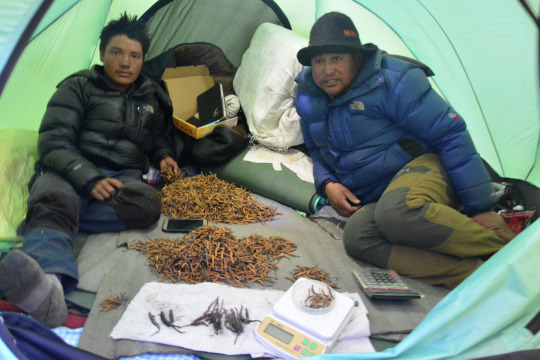
Slika 63: Dileri yarsagumbe

Slika 64: Jutarnja romantika ispred brloga na +4309 mnv
Dan 8
Na naše veliko iznenađenje, ujutro su se Yarsaši počeli pakirat, rastavljat šatore i ić ća! Kaže Lal da su tu mjesec dana i to je to, gotovo, odlaze. Odlazimo i mi, danas je dan D - napokon ulazimo u Dolpo. Nakon 200 metara laganog uspona dolazimo do prijevoja Jangla Bhanjyang (+4513 mnv), ulaza u Dolpo, iza kojeg se lagano spuštamo prvo kroz plitki snijeg, a potom kroz nisku travu i kamenjar. Hodanje nizbrdo ne čini dobro mojim koljenima, ali sam sretna jer znam da je sutra dan za odmor, kojeg sad već debelo priželjkujemo.
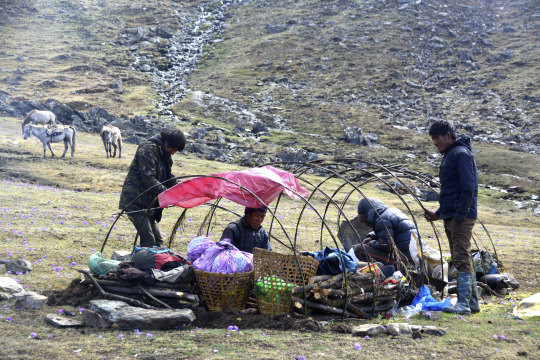
Slika 65: Rastavljanje DIY šatora - konstrukcija od bambusa i kineska cerada

Slika 66: Ovako se pakiraju Yarsaši

Slika 67: Luki se ova stijena posebno svidila. Stari pokvarenjak!

Slika 68: Iza prijevoja Jangla Bhanjyang snijeg, kao dobrodošlica u Dolpo
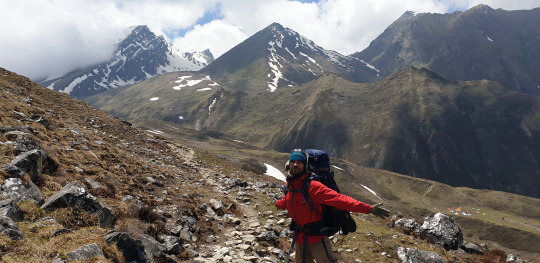
Slika 69: The sound of music, Himalayan style

Slika 70: Pastirska kućica usred ničega
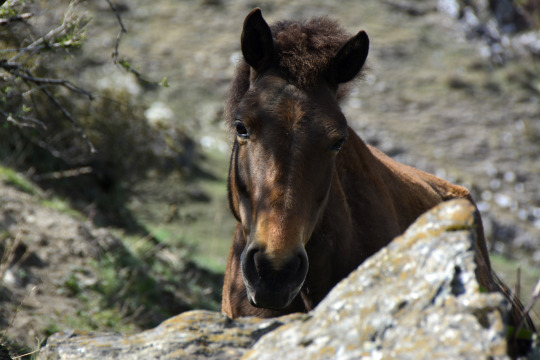
Slika 71: Naočiti konj
U popodnevnim satima stižemo u Sahartaru (+2884 mnv), prvo konkretnije naselje na našem treku - ima školu, dućan, ured državne uprave. Ali nema žive duše! Naravno, svi su išli u yarsu. Dolpo se nalazi u sjeni Himalaja pa monsumski oblaci nikad ne pređu sjeverno od visokih vrhova Dhaulagirija; ambijent je dosta pustinjski, postapokalptičan, krajolik je suh i gol, a kuće ravnih krovova ožbukane blatom podsjećaju me na moju mladenačku viziju Nevidljivih gradova Itala Calvina. U jednoj od takvih kuća Lal nam je uspio ispregovarat smještaj i hranu, kod nekih nonića koji se uopće ne bave ugostiteljstvom, a valjda su prestari za ić u yarsu pa im nije mrsko zaradit koju kintu ovako. Smjestili su nas u sobicu na najgornjem katu kuće - to je prirodni poredak, jer prizemlje je rezervirano za štale i za wc, a oni žive na 1. katu. Do gore se penje ljestvama koje su izrezbarene u deblu, i sama radnja nije toliko teška, koliko nepraktična kad recimo usred noći moraš na wc. Nekoliko puta. Ali s terase se zato pruža divan pogled na planinu prekoputa i naselja slična ovom na njenim padinama.
Čim smo došli, prva stvar koja nam je bila na pameti je - pranje. U selu postoji jedno jedino mjesto gdje se čovjek može oprat, a to je wc u državnom uredu, gdje su šlaufom doveli vodu s izvora i instalirali pravu pravcatu špinu. Kako su državni službenici otišli u yarsu, tako smo mi slobodni otić tamo i na miru se oprat, goli golcati. Dobar osjećaj! Da svečano obilježimo ulazak u Dolpo i kraj prve etape našeg treka, a i rođendan moje mame koja je sad 6000 km daleko od mene, pokušali smo nabavit pivo (sad smo dovoljno nisko da se trenutno ne bojimo visinske bolesti pa si možemo dozvolit malo alkohola). U jedinom seoskom dućanu piva nažalost nema, ali je Lal uspio od neke babe nabavit chaang, domaće pivo od ječma, ali nažalost još nedozrelo. Kiselo je i zrnato, ali nismo izbirljivi. Kao šlag na tortu došla je i činjenica da u Sahartari ima signala, doduše slabog, pa sam se danas prvi put nakon 8 dana dopisivala s mamom i sestrom, koje sam još prije nego šta smo krenuli na trek opširno u mailu upoznala s našim planom kretanja i rekla im da zovu nepalski GSS ako se ne javimo do nekog datuma. Ne treba reć koliko su sretne da do toga ipak nije došlo :)

Slika 72: Kuća u Sahartari sa šarenim drvenim prozorima karakterističnima za Dolpo

Slika 73: Lower Sahartara - plavi limeni krov u prvom planu je jedini kosi krov u selu - to je škola

Slika 74: Kuća u kojoj smo prespavali, i gazda na jednom od krovova

Slika 75: Luka na krovu, dole lijevo vijuga rijeka Thuli Bheri

Slika 76: Na brdu prekoputa, osamljeno naselje slično ovom
Dan 9
Jutro smo proveli povlačeći se po vrećama za spavanje, dremuckajući i čitajući knjige. Koliko god sam žudila za tim jednim lijenim danom, ipak sam bila nervozna, šta zbog smrada tepiha na kojem smo spavali, a šta zbog količine mušica koje su nas neprestano oblijetale. Ručali smo dal bhat i krenuli se pakirat, jer nećemo prenoćit tu nego par kilometara dalje, u kampu pokraj rijeke. Pozdravili smo se s domaćinima i krenuli dalje nizbrdo, kroz opustošeno selo, pokraj nekoliko gompa, do Tarakota. Rijeka Thuli Bheri koja ovuda teče ide prema Dunaiu i dalje se ulijeva u nama dobro poznati Karnali. Ovo je u povijesti bila glavna trgovačka ruta između Tibeta i Indije, a područje je pripadalo antičkom tibetanskom kraljevstvu Tichurong, s Tarakotom kao prijestolnicom. Po veličini ne veći od nogometnog igrališta, Tarakot neumoljivo podsjeća na srednjevjekovne utvrđene gradove kakve smo navikli viđat u Europi. Interesantan detalj su kruništa od osušenog drva na ravnim krovovima, koja predstavljaju statusni simbol: šta više drva imaš, to si veća faca. Ovaj neobičan običaj jedan je od razloga zašto je šuma u blizini sve rijeđa i rijeđa, iako je nadmorska visina dovoljno mala da bi drveće raslo. Drugi razlog je taj šta je drvo glavni i jedini energent za grijanje i kuhanje; ljudi često moraju prevaljivat ogroman put da bi nabavili tu osnovnu životnu potrepštinu. U Dolpu ljudi žive uglavnom od poljoprivrede, uzgajaju ječam, krumpir, heljdu, proso, pšenicu, špinat i rotkvice, i to teškom mukom jer kiše nema pa se polja moraju navodnjavat. Sve ostalo se kupuje u Dunaiu, i to po skupim cijenama jer treba sve to dopremit avionom, šta je užasno skupo, ili na mulama, šta traje dugo. Onda opet, od Dunaia do bilodi treba najmanje nekoliko dana hoda, pa onda čovjek padne na guzicu od iznenađenja kad na ovako nekoj kamenoj kućici bogu iza nogu ugleda - prozorska stakla.
Kasnije popodne stigli smo u kamp na +2500 mnv, digli šator i večerali dal bhat u bhattiju. Sutra idemo prema sjeveru, prateći rijeku Tarap Kholu, još dublje u Dolpo. Ali to je već materijal za idući post!

Slika 77: Prava je majstorija spustit se ovim ljestvama
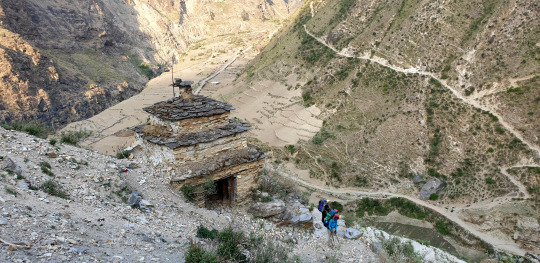
Slika 78: Spust prema rijeci

Slika 79: Kane chorten - kapija Tarakota

Slika 80: Prva polovica gotova! Ali još je dug put pred nama
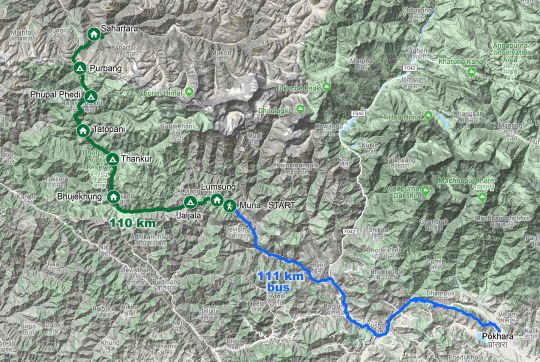
Slika 81: GPS track

Slika 82: Profil prvog dijela treka; gore - dole, pa tako u nedogled
1 note
·
View note
Text
🎭 #JimmyHughes
https://m.facebook.com/groups/466408573914808?view=permalink&id=559682394587425
🎭 #IncredibleRealStoryOfHowardHughes
https://youtu.be/8KysC3_vI3E
youtube
🎭 #HowardHughes https://betterhomebusiness.tumblr.com/post/187555387293/hughes-youtube
🎭 #Hollywood 🎭 #HowardRHughesJr
https://betterhomebusiness.tumblr.com/post/187579190688/hollywood-howardrhughesjr-in-1926-hughes
🎭 In 1926 Hughes moved to Hollywood, where he became known for making films that ran both over budget and afoul of censors. He produced several movies—notably the Academy Award-winning Two Arabian Knights (1927)—before beginning work on Hell’s Angels in 1927. Numerous problems plagued the shoot. Originally intended as a silent film, it had to be reshot as a talkie. In the process, Greta Nissen was replaced by Jean Harlow. Several directors also left the production, and eventually Hughes took over. The film was finally released in 1930. While the storyline—two British pilots fall in love with a socialite during World War I—proved uninspired, the film’s stunning aerial sequences were considered groundbreaking. The drama was a box-office hit, though it failed to recoup its production costs, which were in excess of $3 million.
🎭 #HellsAngels
https://youtu.be/8DFFYHPbG9A
youtube
🎭 Hughes then produced a series of movies, notably Scarface 1932, which was based on the life of Al Capone. The shoot was marred by frequent arguments between Hughes and director Howard Hawks. In addition, its release was delayed by censors at the Hays Office, who demanded various changes to the violent and brutal film. In the end, it was a huge hit, and Paul Muni, who was cast in the title role, became a major star. Hughes later produced and directed The Outlaw 1943, about Pat Garrett, Doc Holliday, and Billy the Kid. However, most of the attention was focused on newcomer Jane Russell, whom Hughes cast as a love interest and outfitted in highly provocative clothing. He designed a special brassiere to accentuate her assets, though the actress later stated that it was never used during filming. Unsurprisingly, Russell’s wardrobe ran afoul of censors, and the lengthy battle between Hughes and the Hays Office generated much publicity, helping make The Outlaw a huge success.
#Twitter #Facebook #Tumblr #LinkedIn #Wix #WordPress #Instagram #Google #UpComingEvents #WaltripClassOf1970 #JimmyAndLydia #JimmyAngel #JimmyBond #JimmyDean #JimmyElvis #Jimmy #HowardHughesJr #NoPlaceLikeHome #JimmysPlace #JimmyEveritt #ForAllMankind #Hughes #IfYouBuildItTheyWillCome #JimmyValentine ❤





0 notes